Cupra Leon VZe Sportstourer 2026 review
Spain’s big-booted PHEV small performance wagon brings class, dynamics and outstanding efficiency, but it’s pricey
Often overlooked is the Volkswagen Group’s sheer breadth of compelling metal. Vee-Dub’s new Tiguan SUV, Audi’s electro-heroic R8 E-Tron GT, Skoda’s fresh ‘Modern Solid’ Enyaq wagon, Porsche’s pulse-blasting 911 GT3…just to cherrypick four diverse and interesting critical darlings of their respective segments.
Cupra? The segment-blurring Formentor half-wagon/half-SUV has been a Chasing Cars favourite, especially in hotter trims. Its hottest five-cylinder VZ5, a unicorn now finally confirmed for Australia mid next year, cannot land itself in our team garage quickly enough.

But one of the most interesting options in the broader VAG lineup is the Sportstourer wagon version of Cupra’s just-facelifted Leon lineup, to date a purely small hatchback offering and one technically related to Volkswagen’s Golf. And not merely because the Golf wagon has been dropped from the local lineup.
Cupra’s conspicuous schtick is that it only offers sporty, driver-focused models. Less apparent is that it’s VAG’s most powertrain-diverse brand, a mix of ICE, (mild) hybrid, BEV and PHEV where the last two powertrain formats account for 42 percent of local sales thus far in 2025.
The 2026 Leon VZe Sportstourer – the only trim offered – blends sportiness, small wagon practicality with a new ‘Gen2’ plug-in hybrid drivetrain based around seemingly humble 1.5-turbo petrol front-drive format that somehow plies hefty 200kW and 400Nm outputs pinned together with eye-raising 0.4L/100km consumption and 121km electric-only range claims.
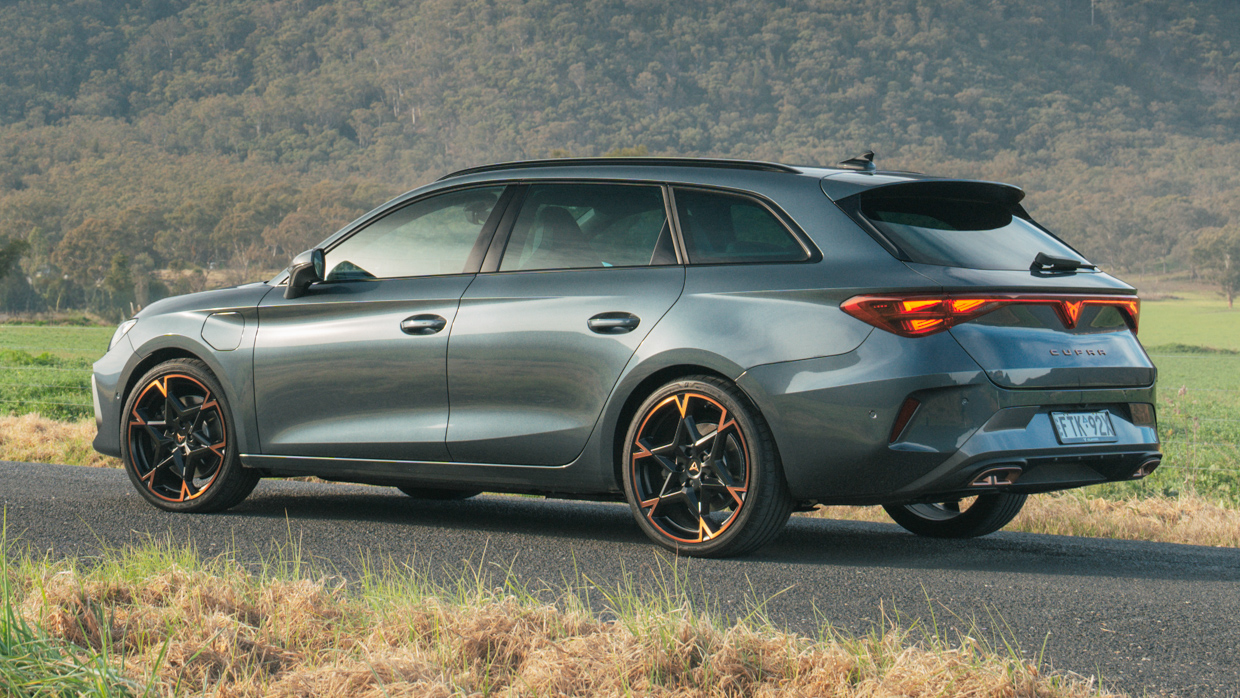
On paper, it’s arguably the most Cupra model variant in the brand’s showrooms right now.
It’s launched as part of the facelifted Leon update in conjunction with a new, modest 110kW/250Nm 1.5 mild hybrid-powered S variant and the (facelifted) return of the genuinely stout ICE-pure 221kW/400Nm VZX hot hatch, both of which we’ll review in due course.
But it’s really the new go-fast PHEV small wagon, a real anomaly on the local landscape, that grabs Chasing Cars’ curiosity the hardest.
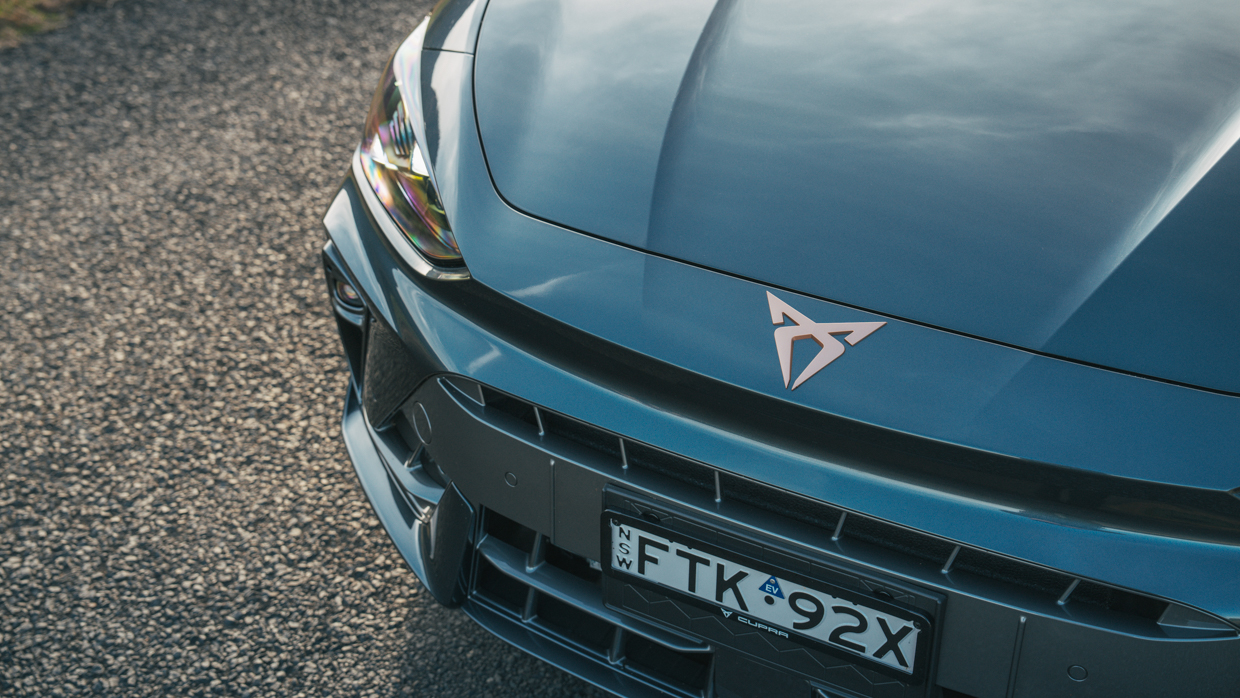
Add a fulsome features list and a heady circa-$70K pricetag (more below), and the Sportstourer has the potential, if executed with aplomb, to be an inspired amalgam of many virtues for many buyers. Or, perhaps, there’s the potential for it to fall flat in its somewhat lofty ambition of covering so many bases in one package.
What are the Leon VZe Sportstourer’s features and options for the price?
New-for-Oz Leon Sportstourer wagon is currently only offered in 200kW plug-in VZe guise, listing for $69,990 before on-roads. However, Cupra Australia has confirmed that a hotter and pricier 245kW petrol all-wheel-drive VZx wagon is due locally in mid-2026.
The sole wagon sits atop the 221kW Leon VZx hatchback ($64,990 list), in price if not in output and performance.

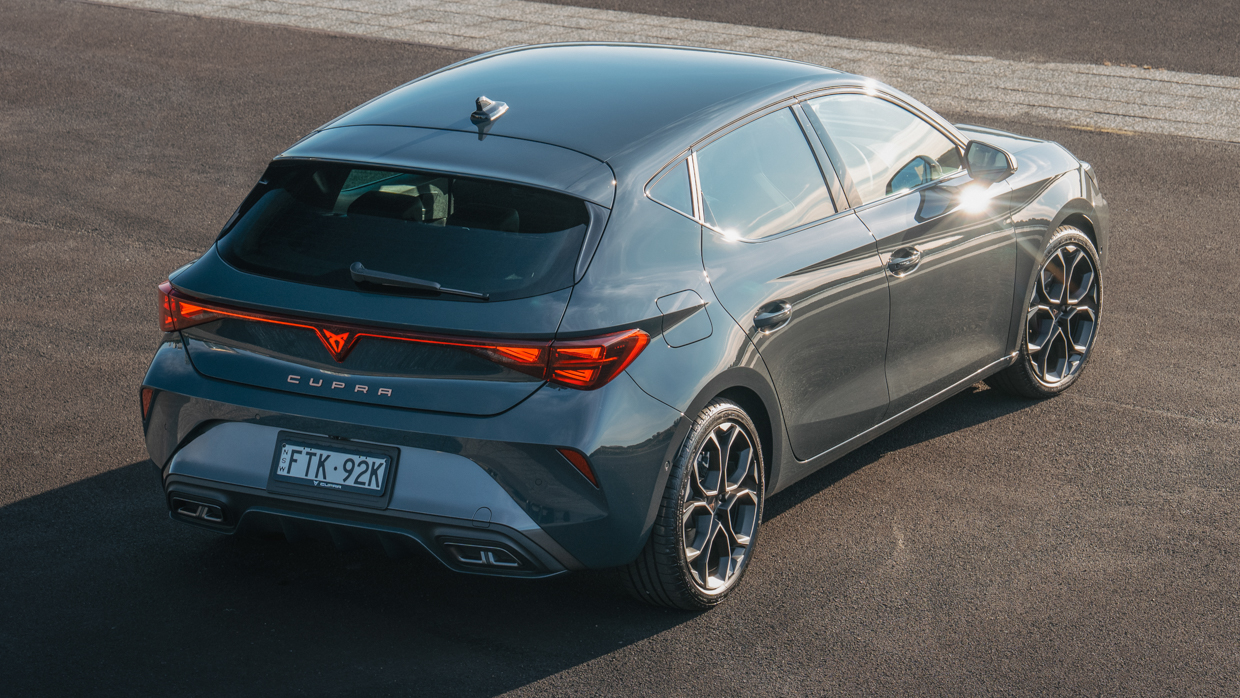
The third and final Leon variant of the facelifted lineup is the new price-busting S variant, which drops the admission price for Cupra’s small-segment nameplate down to $46,990 before on-roads. A 150kW VE mid-range hatch will join the fold in early 2026.
Standard features for the Sportstourer VXe include:
- 19-inch ‘Polar’ black and copper wheels
- LED headlights and tail lights
- DCC adaptive suspension damping
- Powered tailgate with kick sensor
- Front sports seats with power and heating
- ‘Moonslate’ leather-appointed seat trim
- Heated, paddleshifter steering wheel
- 10.25-inch digital driver’s instrumentation
- 12.9-inch touchscreen media
- Wireless Apple CarPlay and Android Auto
- Single inductive phone charging
- 12-speaker 390-watt Sennheiser audio system
- Three-zone climate control
- Ambient lighting
- Reversing camera
- Front and rear parking sensors
- Mode 2 and 3 charging cables
A panoramic glass roof with front tilt and slide is available at a $2000 upcharge ($1800 for hatchback).
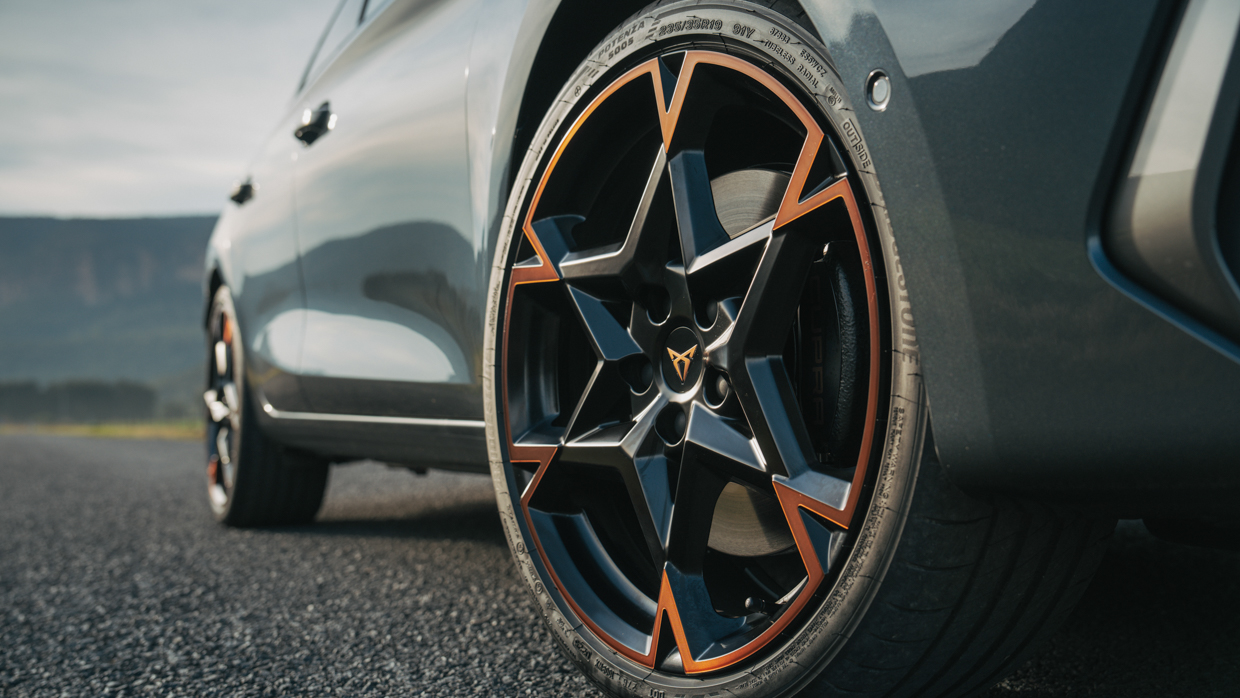
There are 10 colours available for the lineup. Standard no-cost colours include Fiord Blue, Glacial White, Magnetic Tech and Midnight Black, while three premium choices in Taiga Grey, Graphene Grey and Dark Void all cost $620. A further three matte options called Century Bronze, Enceladus Grey and a satin version of Magnetic Tech want $2650 apiece.
Not offered for Sportstourer are the Leather & Sound pack ($2200) for the base S and a tasty Extreme Package ($7600) with six-pot Akebono brakes and carbon-fibre shell race-style bucket seats, the latter reserved exclusively for the VZx hatchback.
How does the Leon VZe Sportstourer drive?
Rule (or strongly suggested guideline) number one: don’t buy a PHEV if you’re not going to plug it in regularly. Buyers who get lazy are better off with the (rather excellent) Skoda Octavia RS wagon and wipe the Cupra wagon from the shopping list.
Why? Because you’ll only get all of the oomph, a considerable 200kW and 400Nm at that, and exceptional electric range (121km claimed) and combined fuel economy – excellent at around 2.8L/100km as tested, if somewhat higher than the advertised 0.4L/100km claimed.

Hose-dodging will return consumption closer to the six-litre mark on a low or dead battery, where the little 1.5-litre turbo four is working constantly and you mostly miss the wonderful torque filling effect of the electric motor that makes the VZe powertrain refinement oh-so silken.
Local ‘Gen2’ PHEV powertrain breakdown stats are thin on the ground, but the European specifications – with its nigh on identical output and range credentials – has outputs at 130kW/250Nm for the 1.5 turbo engine and 85kW/330Nm for the electric motor assistance, the latter using a 20kWh (net) battery.
And just how superior the PHEV system is to the (110kW/250Nm) 1.5L turbo mild hybrid format is shocking when sampling both back to back, as we did at the Australian range launch of face-lifted Leon.

The mild system, as fitted to the lightweight S hatch, is rorty and energetic, but sweats for its keep and lacks fundamental response crispness at times. The 48-volt assistance struggles to putty over some shady synchronicity between the engine and the seven-speed dual-clutch gearbox.
The PHEV, though, launches cleanly, smoothly and near silently, be it driven gingerly or when called to march. Thrust is heady, thanks to the undertow of an additional 330Nm of electric torque, with a swelling energy that’s lusty and satisfying if not as crackerjack potent as the 221kW 2.0L VZx hatch. Stands to reason.
Actual pace? At 7.3 second 0-100km/h claimed, the portly 1760kg wagon is well shy of the lighter, more-powerful (5.7sec) VZx hatch. But the numbers do sell the usable, roll-on energy of the PHEV system well short.
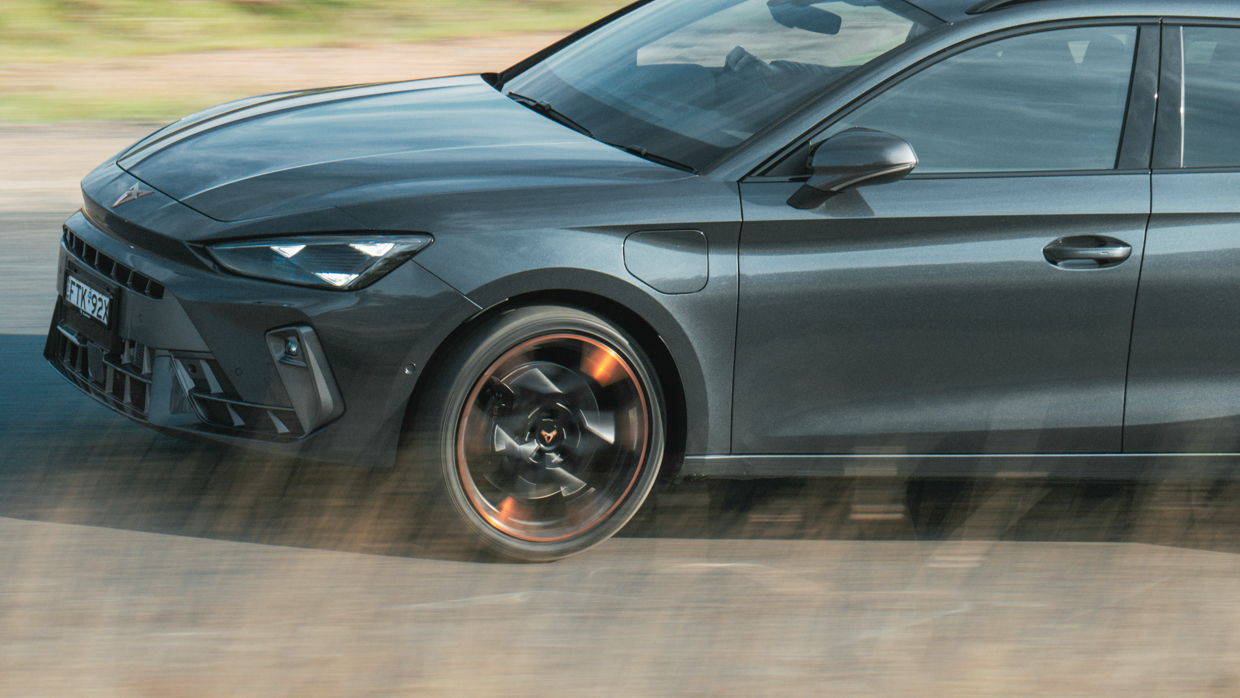
But it’s just how clean and silky this powertrain delivery is that impresses most. The turbo engine dips in and out of drive so inconspicuously via a six-speed ‘wet’ dual-clutch that the only genuine annoyance on the move is the driver’s display: a white crescent for engine rpm pops into and out of view distractingly as the engine clocks on and off duty, near silently.
Recharged and left to self regulate drive in normal ‘hybrid’ mode, consumption can vary wildly depending on location and driving style.
Kicking off in regional New South Wales, attacking country backroads with 100km/h average speeds, it sees sixes…before eventually landing at the aforementioned 2.8L average across balanced driving, once you’ve tamed the pace down. We covered around 300 kilometres across two days in the Sportstourer, and high twos was the consistent theme.

Dynamically, the wagon’s longer (4656mm versus 4398mm) and heavier form – with much of it in big-boot rear overhang – makes it a touch more ponderous to change direction than its hatch siblings. Further, the packaging of the PHEV gubbins add a certain ‘swing’ to the rear end of the front-driver.
But it is sporty and fun to punt, with shades of Cupra spunk in its attitude. It’s a grand tourer by intent and certainly that’s the role it slips most comfortably into on road, but not to the detriment (too much) of dynamism and driver connection. It’s still crisp and engaging.
Cupra prides itself on a characteristic steering ‘feel’, in linearity, feedback and in the related obedience of the front end. But where it convinces enough as a driver’s tool that’s faithful to the Spanish brand’s recipe is that its canny balance remains resolute even when you strong-arm the chassis beyond the available grip (which is pretty handy in itself).
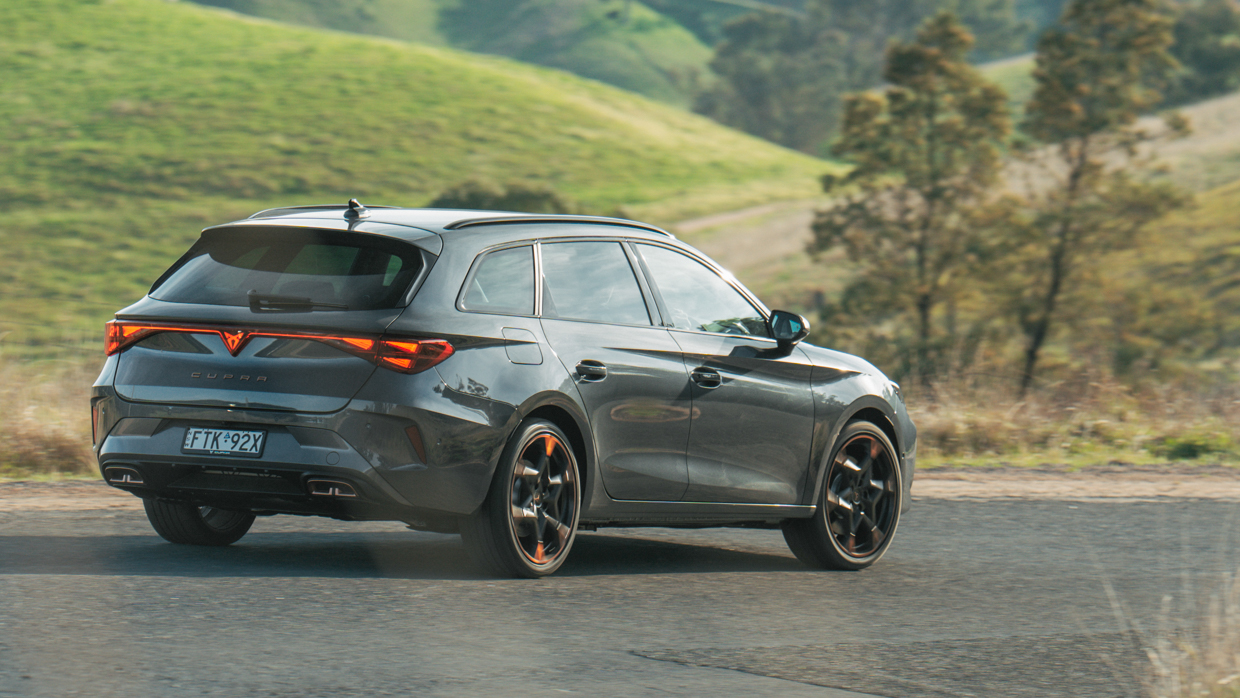
Normal play for a hot hatch, but for a front-drive, plug-in family wagon…
Ride, too, is excellent. It fits the familiar VAG Dynamic Chassis Control sprinkled with Cupra’s own fairy dust in overall tuning, with a result we’ve seen many times before: the middle settings so sweetly blend ride comfort with body control that you simply set it and forget it.
Downsides? Precious little. In normal drive mode, the natural regeneration brought on by the PHEV system is a touch strong, but that’s nitpicking what’s an otherwise uncompromised long-hauler with incredible frugality and enough spice for serious backroad adventure.
What is the Leon VZe Sportstourer’s interior and tech like?
There’s no mistaking the brooding, Gothic vibe the Cupra designers have fallen headfirst into and the facelifted Leon, including its big-butt Sportstourer guise, certainly doesn’t deviate from the theme. In fact, there’s not a lot facelifted inside from the old cabin, bar a slightly slicker centre console array.
Of course, there’s some unmistakable kinship with offerings from cousins Volkswagen and Skoda, especially in areas of visual/media tech and some of the user interface. The often overlooked and positive upshot of this is that Cupra (and Skoda) offer buyers the Volkswagen experience they might be after with a distinctly different flavour.
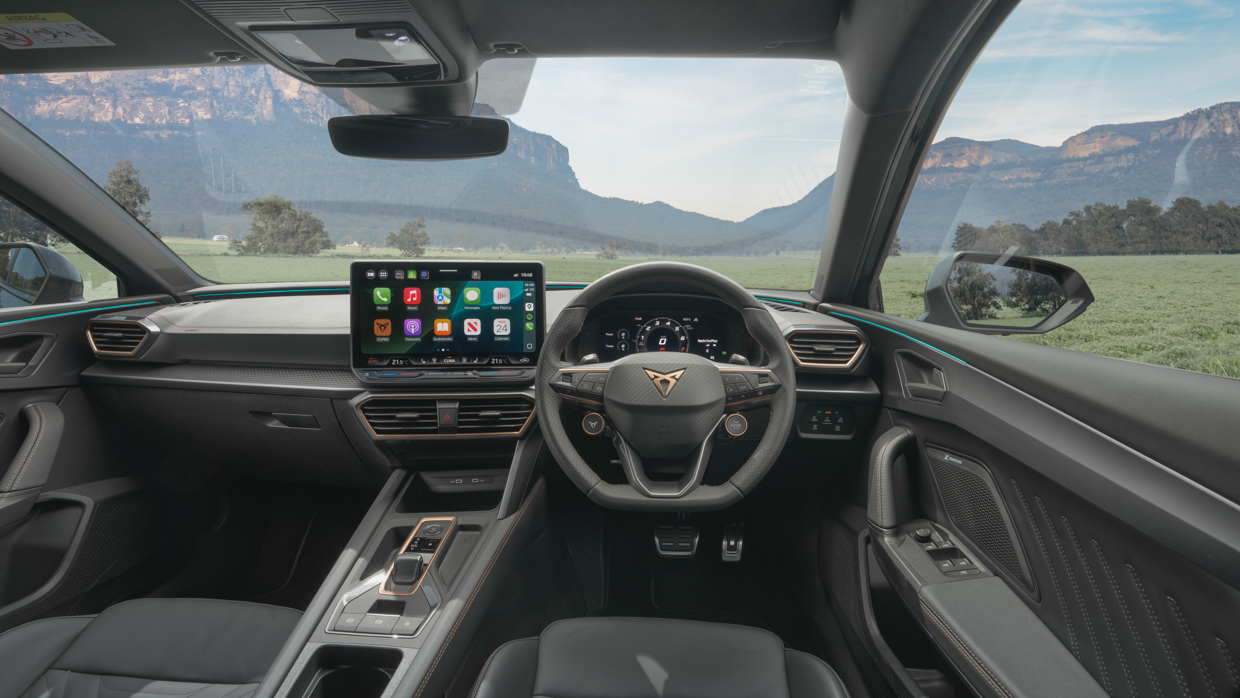
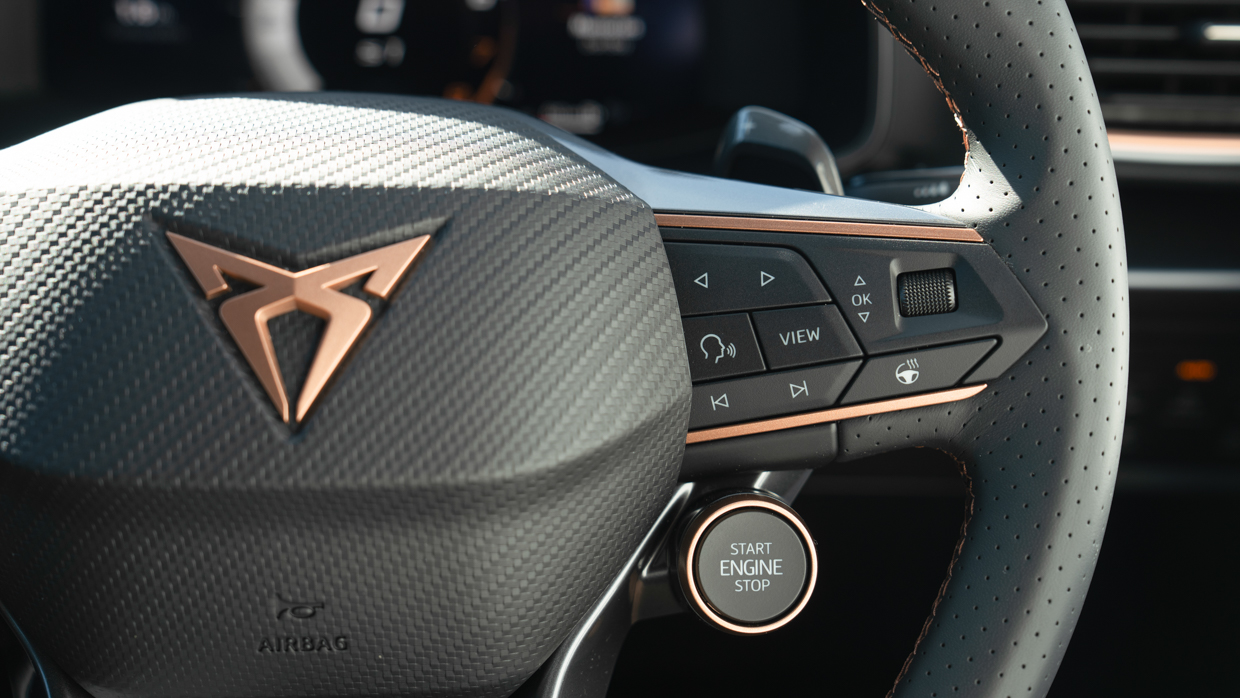
For your reviewer’s personal tastes, Cupra creams Volkswagen for interior design maturity, richness, premiumness (in select areas) and a sense of occasion… even if, yes, it’s a bit gloomy.
The cabin of the Leon is far more preferential to that of a Golf GTI what with its incongruent candy colours and slightly tacky ‘yoof-ful’ zing unfit for the sort of money a fast front-drive small Volkswagen commands.
The Cupra wheel is neat, the variety of driver display skin a little more Audi-like, and the restraint on the display colours and subtle horizon line mood lighting – which transmits some safety visuals, such as blind spot indication – has a nice restraint to it. Not many conspicuously cheap plastics, either.
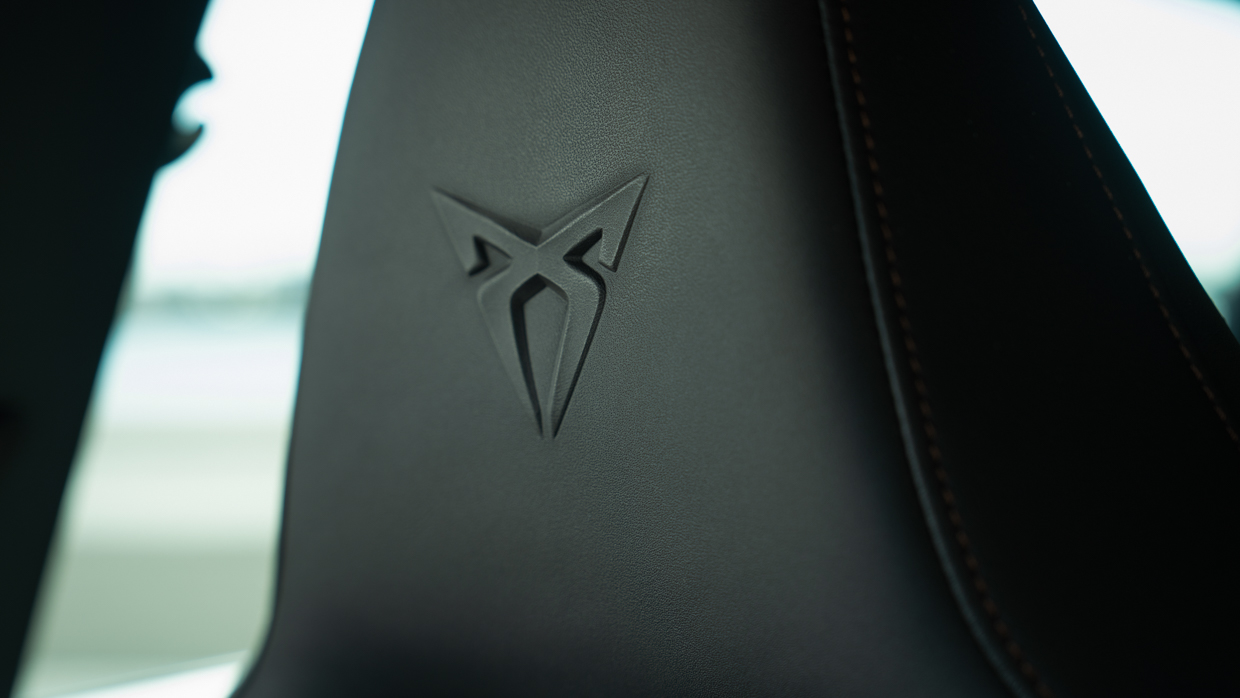

The seats are really good, to a point. They score highly for sporting purpose but could do with a touch more natural comfort, at least after spending hours at the helm. We did sample the optional Extreme Package race buckets in VZx hatch during the launch program and they are utterly brilliant all-round.
Feature wise, there are enough goodies to justify the wagon’s heady $70K pricepoint…which only goes to show how good value the base S is given the price-buster shares the same 10.25-inch driver’s display and fulsome 12.9in media touchscreen, as well as the three-zone climate control.
However, the higher-grades’ so-called Moonslate leather appointment across the seats is nice, supple and welcoming, though for the money the Sportstourer asks for the lack of seat ventilation is a somewhat disappointing.


VAG’s silly slider adjustment for aircon temperature persists, but at least they’re illuminated in the Cupra format. And while the media format’s menuing isn’t the last word in intuitive simplicity, this version of the operating system presents handy assignable shortcut icons on the homescreen.
The extra 258mm of body length over the hatchback allowed designers to balance second row space with a nice deep boot that, in PHEV guise, is a very usable 470 litres (and that’s as much as 620 litres in ICE versions offered in Europe).
There’s ample knee room, a decent sense of airness despite the gloomy cabin theme, and the third-zone climate control is complimented by USB-C device power.

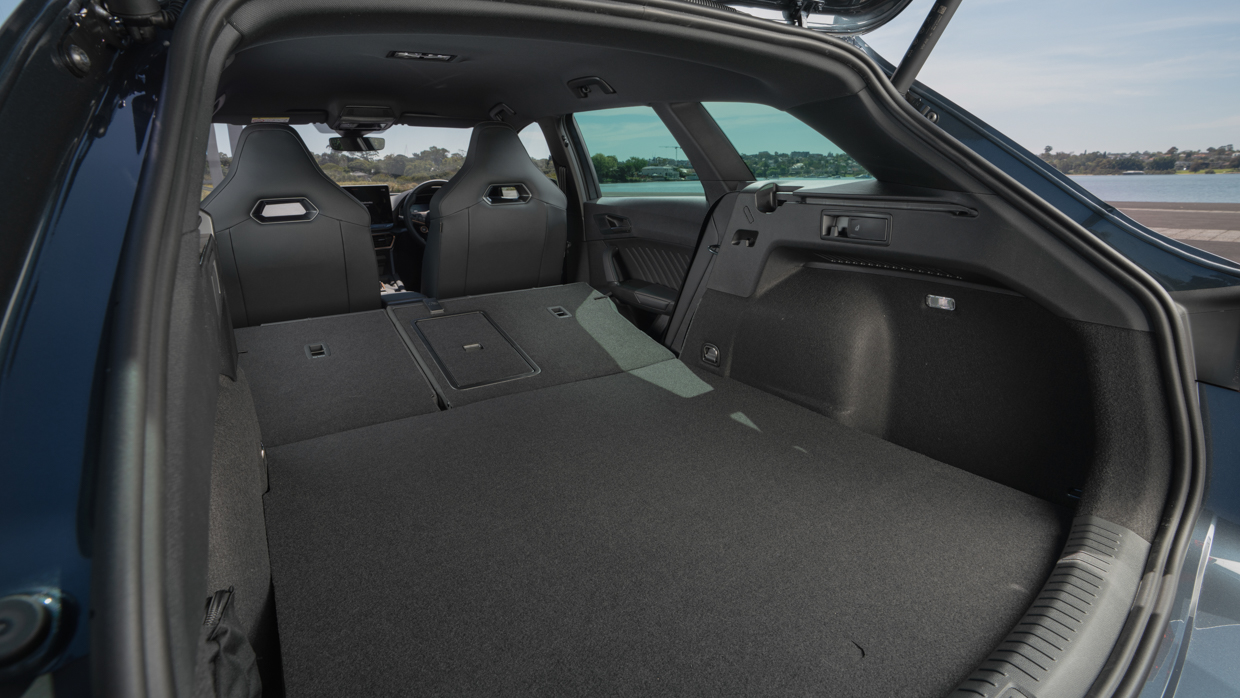
A pronounced hump in the centre of the rear bench will limit comfort for adults three across – ditto the prominent tail shaft tunnel put to use in next year’s all-wheel-drive versions – but there is enough room for five-up accommodation at a pinch.
Is the Leon VZe Sportstourer a safe car?
As a facelift, the Leon carries over a five-star ANCAP assessment based on testing on the related Seat Leon (by Euro NCAP) conducted back in 2020, which applies to all variants including plug-in hybrids. This rating is due to expire in December 2026.
It scored 91 percent and 88 percent for adult and child occupant protection respectively, with 71 percent for vulnerable road user protection and 80 percent for safety assist.

Features fitted include:
- 10 airbags including front centre airbag
- Forward AEB with pedestrian and cyclist detection
- Lane departure warning
- Lane keeping assist
- Blind spot detection
- Rear cross traffic alert
- Exit warning
- Driver monitoring system
- Tyre pressure warning
- Traffic sign recognition (MY26 only)
- Speed limit assist (MY26 only)
During hundreds of kilometres of testing across all three variants of the Leon range, we noticed no annoying or abnormal behaviour, despite fitment of the oftentimes cursed driver monitoring and traffic sign recognition systems.
What are the Leon VZe Sportstourer’s ownership costs?
Like any PHEV, fuel consumption will be wholly dependent on how and where the vehicle is driven and how regularly the battery is recharged.
Of course, average consumption claims for plug-ins – here at 0.4L/100km – is murky, as any vehicle with an EV range claim beyond 100kms – here it’s 121kms – ought to hit triple figures, conditionally, without internal combustion drive at all.
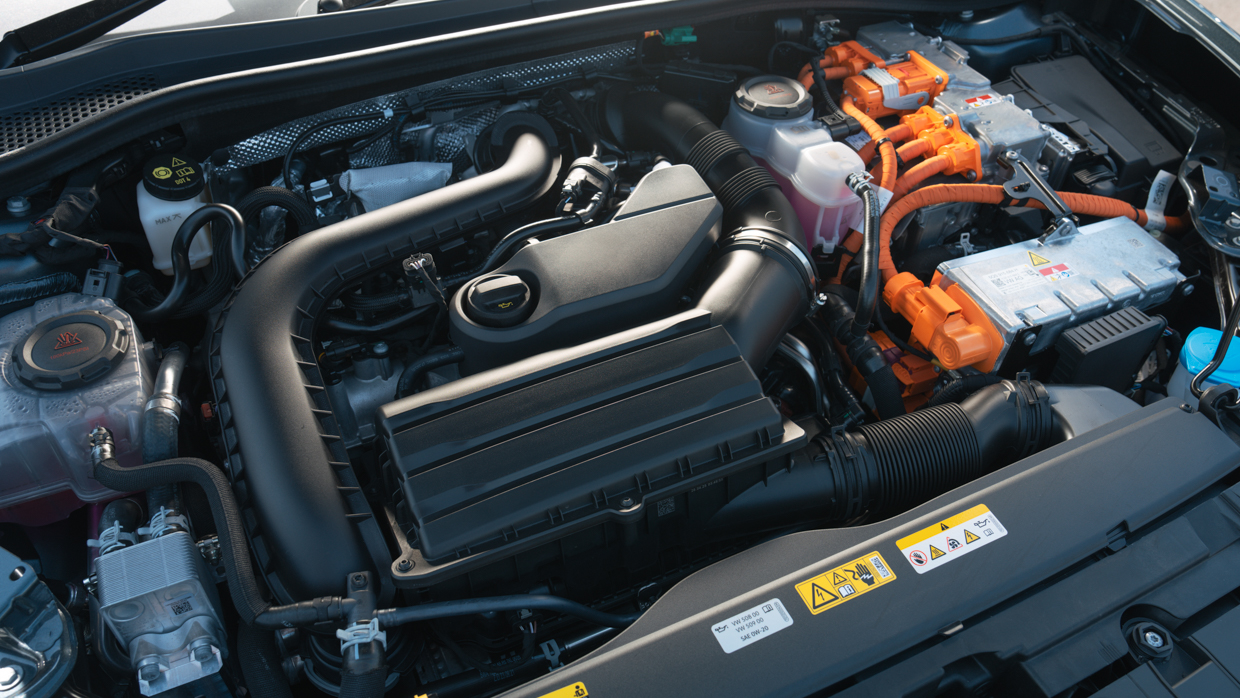
That said, preliminary and not entirely sympathetic testing suggest a real-world consumption of around 2.6L-2.8L over distance, with consumption scaling up to the six-litre mark with a depleted battery. Only a full-tank, fully-charged single journey would return the most accurate figure.
Charging? On its 50kW DC peak the VZe returns a claimed 10-80 percent charge in 26 minutes, while peak AC charging is 11kW. Mode 2 and 3 cables are supplied with the vehicle as standard.
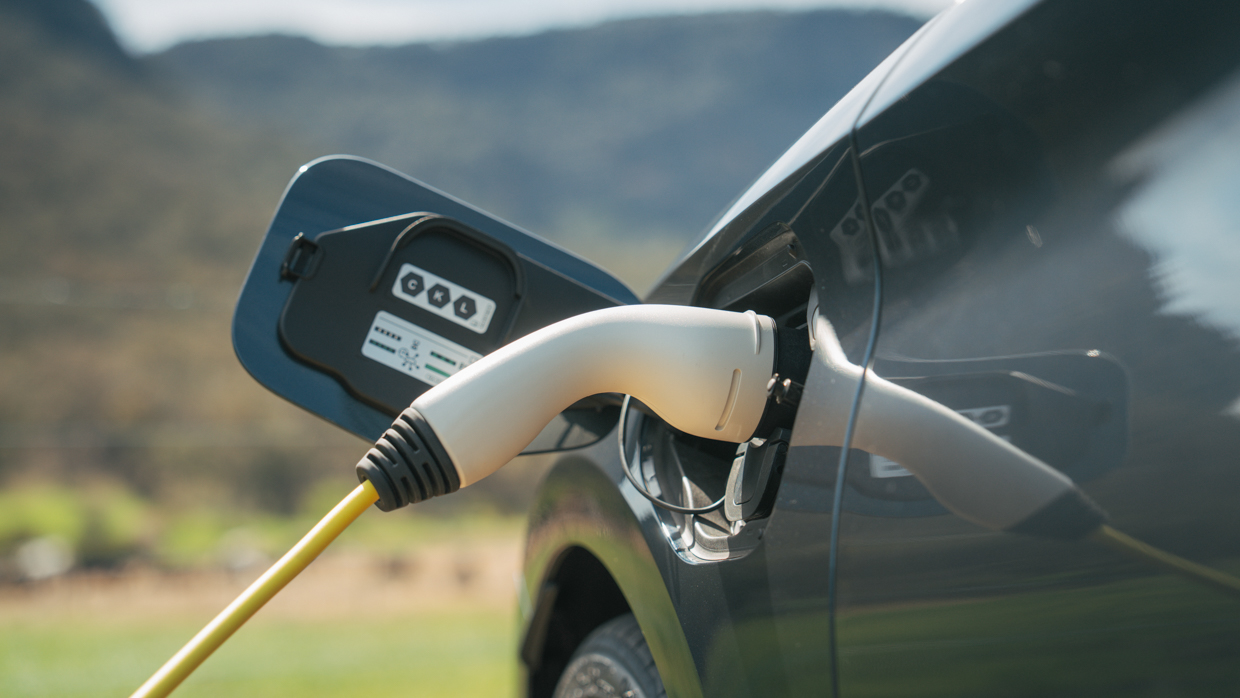
Servicing? Cupra currently advertises a five-year bundle at $1990, with 12-month/15,000km intervals, which the local importer states could change come January 1st 2026.
Warranty is five years of unlimited-kilometre coverage.
The honest verdict on the Leon VZe Sportstourer
Disclosure time. Your author is a wool-dyed petrolhead, has driven the VZx hatch with big-brake/race-seated Extreme pack, and it’s wicked: the enthusiast pick of the litter. And with a 245kW petrol all-paw Leon wagon and the 287kW five-pot Formentor VZ5 confirmed for Oz, 2026 is going to an exciting year for Spanish-bred, ICE-powered fun factor.
And yet, for your author’s real world of daily urban commutes and regular long-haul road trips, for a priority of hushed fuss-free comfort with ample thrills at the drop of a foot, the plug-in Sportstourer makes an incredible amount of sense. If you’re prepared to plug in diligently.

The real trick is to ignore the plug-in’s on paper stat and get over the 1.5-litre engine mental hump. Because in practice, this powertrain returns in character what one would want from a very refined, European-bred V8. Near-silent running, an undertow of torque thrust.
Yes, it demands plugs, cables and user effort. But in driveability, refinement and efficiency, Cupra’s Gen2 hybrid sails smoothly and almost silently well beyond the self-charging hybrid powertrains that Toyota and Lexus owners are accustomed to.
And this powertrain fits the seemingly undying appeal of a sport-infused wagon – loved by gear-heads and journalist types alike – oh-so-well, particularly one as well resolved in nailing its broad array of targets as accurately as the VZe Sportstourer does.
Ford Transit Custom Sport long term review
1 week ago

John Law
Road Test Editor
Utes are the hottest segment in Australia right now, but what about the other commercial staple, the humble van?
Good points
- Easygoing powertrain
- Comfortable ride quality
- Broad, spacious back seat
- Cargo security
- Great forward visibility
Needs work
- Build quality issues
- Glitchy multimedia
- Back seat windows don’t slide
- Thirst for AdBlue
- Hard to reach top tether points
We’ve said it before and we’ll say it again, the dual-cab ute is a deeply compromised family hauler.
Ford Rangers and Toyota Hiluxes might be the vehicle-du-jour at the moment selling the dream of doing weekly dirty work and opening up a whole new world of weekend adventures.

But what about the poor van? Kombis, Transits and Sprinters have been doing double-duty as family-cum-work vehicles for much longer than utes.
Yet in Australia, mid-size vans account for a lowly two percent of the market, and a lot of those sales are from delivery fleets. Combine 4×4 and 4×2 utes and you get nearly 20 percent of sales — yikes.
We’re driving the new Ford Transit Custom in family-oriented (but not workshy) Sport guise with two rows of seating to see if the van deserves more love in Australia.
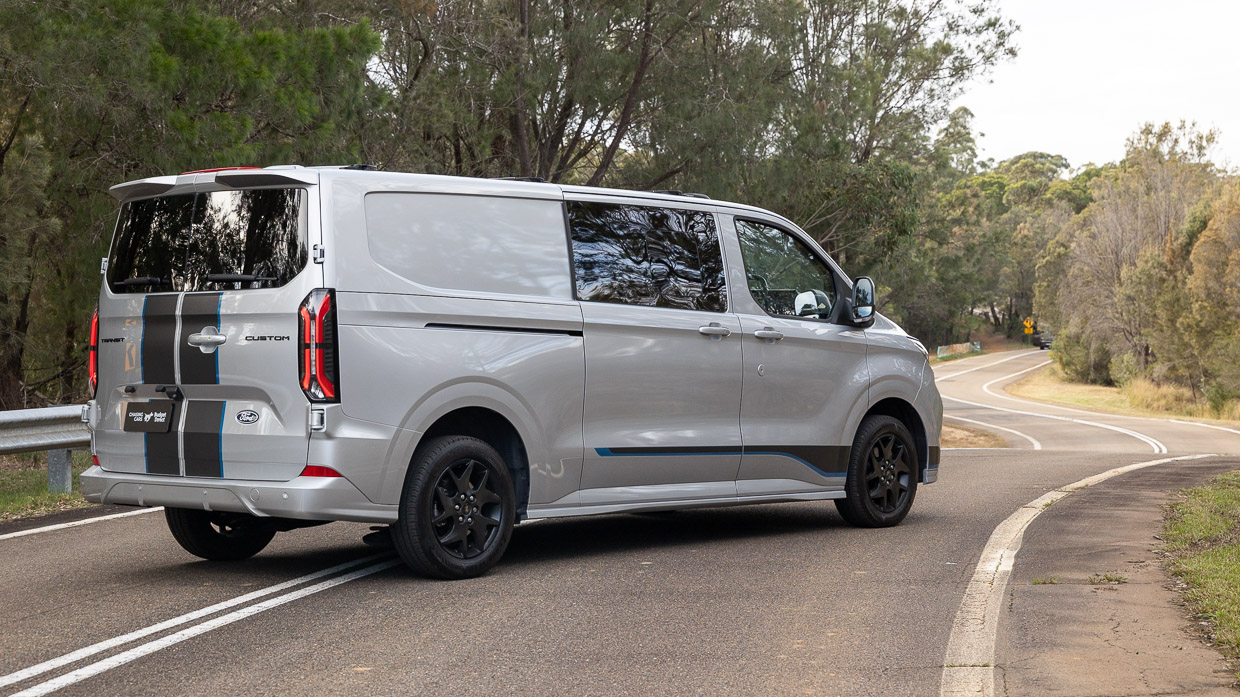
It should have a solid chance, with fairly spiffy cabin appointments including blue-accented cloth upholstery and a large touchscreen with wireless smartphone mirroring.
Driving should be pretty sophisticated as well, with a rear bulkhead insulating the passengers from the classic van rumble. Plus, Ford’s engineered the new Transit Custom with multi-link, independent rear suspension. Sounds sophisticated to us.
Navigate this long-term Ford Transit Custom Sport review
The Final Verdict: Is van-life the answer?
- Total kilometres: 10,154km
- Fuel consumption: 7.0L/100km
And so, after three months, lots of kilometres and plenty of van-friendly activities including moving house, taking a sick dog back and forth to the vet, going on tour with Prime Ministar, plus lugging camera gear from here to there and back again, what do we think of the Transit Custom as an ownership proposition?
As a vehicle to spend a lot of time in, the Transit gets plenty right. The seats are upright and supportive, with a driving position closer to an epically comfortable dining table than motor vehicle. It’s a long way ahead of a Toyota Hilux or LDV Deliver 7.
Practicalities inside are sublime, the double gloveboxes, hidden storage cubby, accessible USB charging points, wireless charging pad, cup holders and layered door bins. The sound system isn’t bad, either.

The Transit Custom is charming, too. Performance is adequate, yet it’s the slick calibration of the Ford that makes it feel so unflappable.
The eight-speed automatic harnessed the best of the 2.0-litre turbo-diesel four in such a way that you’d put good money on the Transit Custom having more than the listed 125kW and 400Nm.
Test the capability with a full complement of passengers, band gear, or Victorian-era cupboards, though, and you’ll notice the strain. Our testing revealed a 10sec 0-100km/h sprint, which is decent but in no way fast.
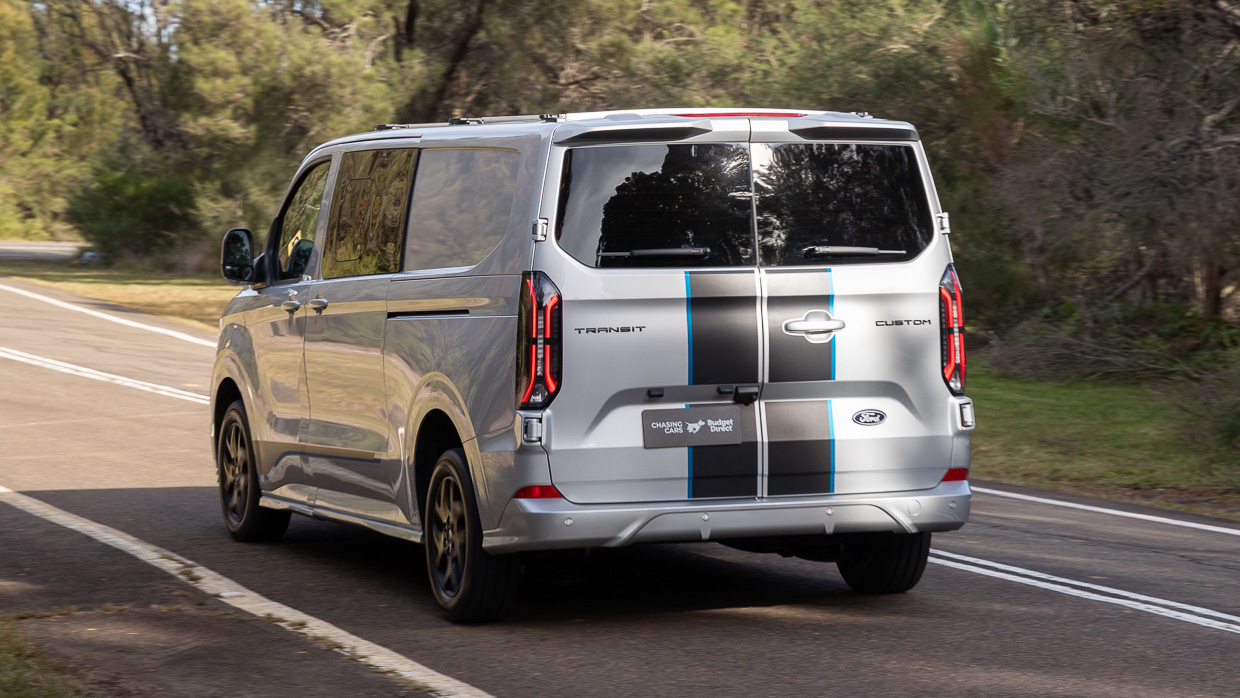
The other great aspect, at least at the start of Transit Custom ‘ownership’, was the ride quality. Improved with its semi trailing-arm suspension from its predecessor, the van’s easygoing nature was replicated in smooth bump absorption.
That said, we noticed an increase in harshness after ticking over about 7000km. It was like the hard-wearing load-rated van tyres had lost the top few millimetres of squidgey rubber that made the Transit Custom such a peach right out of the dealership.
The Transit Custom’s handling, thankfully, remained predictable and surprisingly sporty thanks to Ford’s excellent steering feel.

Road noise grew over time, though, as did some of the build quality niggles. A flappy side-skirt on the passenger side, and the wonky alignment of the rear barn doors, naturally, didn’t improve.
And we never gelled with the multimedia system. Ford’s Sync might be livable in isolation, but when constantly jumping between other manufacturers’ efforts, you notice the clunkiness. It is slow to boot up, and there are a few convoluted settings (such as disabling the engine start-stop system) making for consistent bugbears.
Bright headlights were a boon in the Transhit Custom at night, with LEDs throwing their beams a long way down the road. But the auto high beam is not calibrated well for Australian conditions. Cats-eyes on the road surface and reflective signs faked out the sensors and dipped the beams way too often.
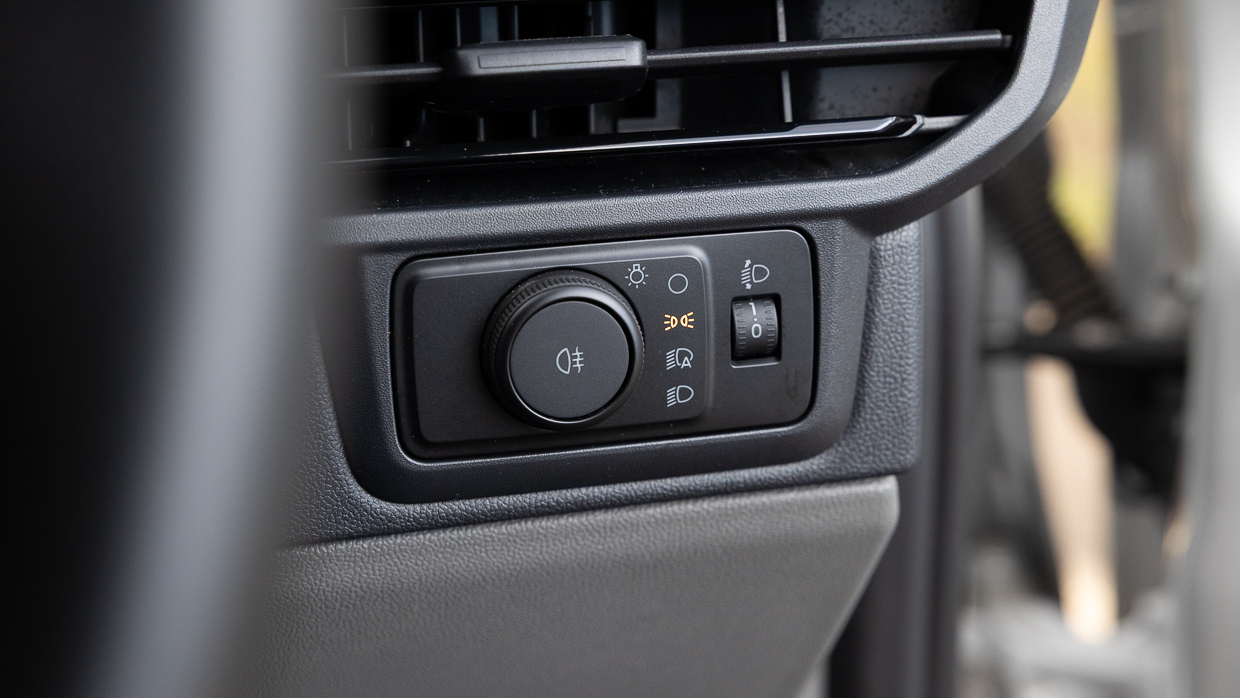
Visibility is interesting with a van. The Transit Custom Sport’s bulkhead has a see-through section so you can peer out the barn doors. Looking out forwards is expansive, and mostly out the side is good save for the chunky B pillars.
A sharp 360-degree camera would have been a nice addition to the Transit Custom Sport, with the wide-angle reverse camera not providing optimal corner-locating excellence. We never scraped metal-work, though, thanks to the easy-to-judge boxy body.
That body was happy to swallow all manner of odds-and-ends. It moved house (what else would you do with a van!) and the low load height of the floor was greatly appreciated compared to the comparatively towering BYD Shark 6 that also took part in domicile-moving duties.
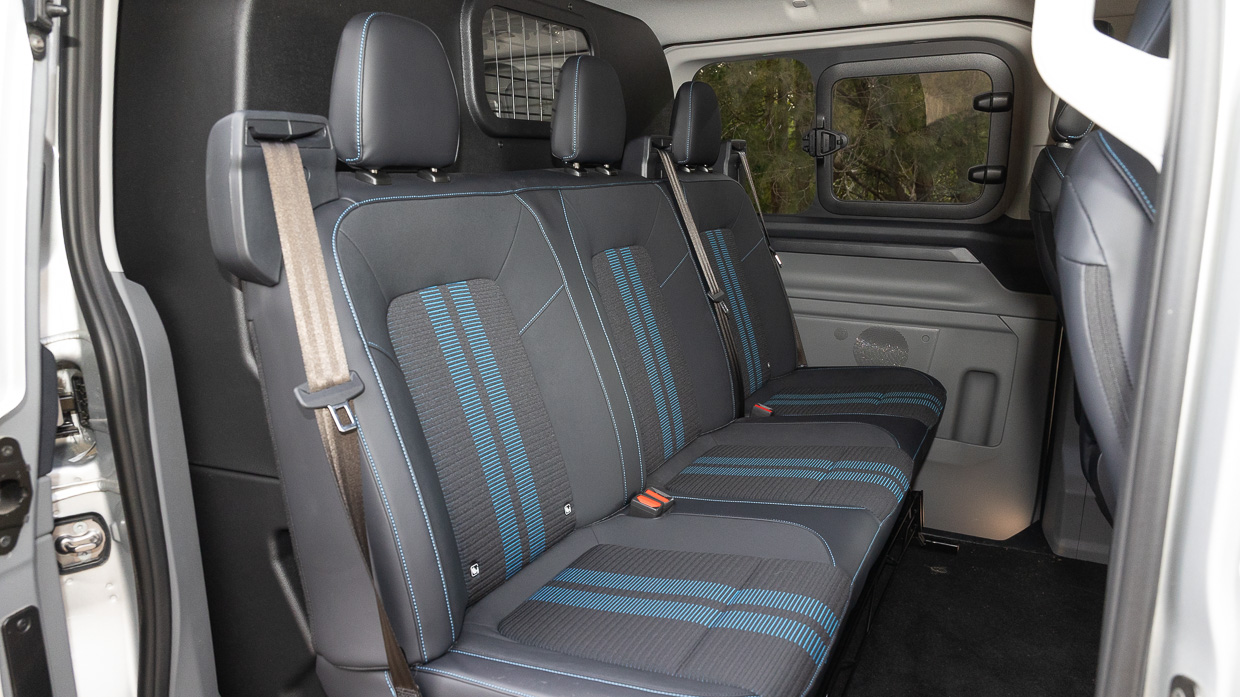
Plus, when transporting precious cargo you don’t feel bad about leaving the Transit Custom around the corner while grabbing your fifth coffee of the day and stretching out your back… Naturally, bicycle-carrying ability is superb. I could have slept in the back, if I wanted, too.
As a family or crew vehicle, the Transit Custom’s back seat has swings and roundabouts. There’s a lot of space, and it’s airy in there yet also dark thanks to the small side windows. Width across the bench is expansive, so it’s a true five seater.
Those with children will find fitting child seats to the almost hidden top tether points to be not worth the hassle. Leave them at home or buy a Tourneo or Kia Carnival. Plus, the windows only pop out — they don’t drop — which annoyed my Kelpie-Collie who loves sticking her nose out the window.
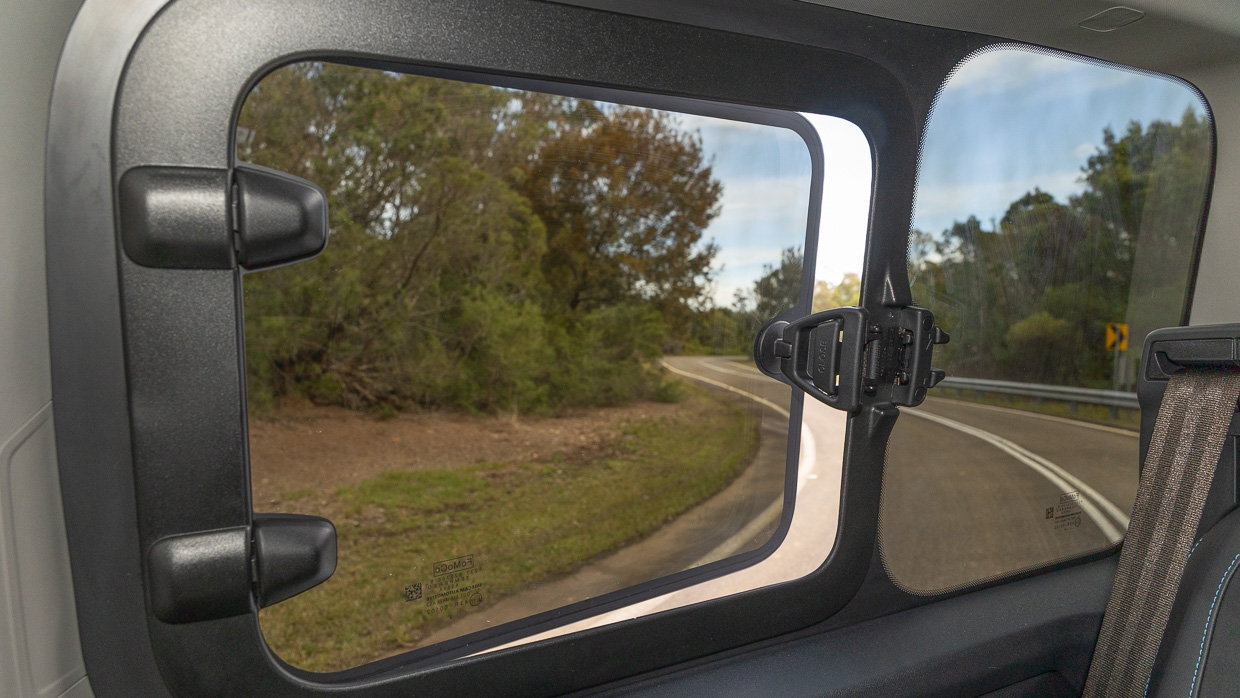
As a long distance tourer, though, the Transit Custom’s economy is excellent. We typically saw sub-7.0L/100km on the motorway when laden lightly, this increased to a little over 7.0L/100km with a load onboard.
The Transit Custom Sport was calling for a second top-up of its 21L AdBlue tank with 12,000km on the odometer, after the first fill (in our custodianship) at 6000km. Ford says a typical AdBlue tank will last 12,000–16,000km, meaning ours was calling for more fluid after half that.
Despite the excellent long-distance chops of the comfy Transit Custom, it didn’t turn out to be the perfect camera car for Chasing Cars.
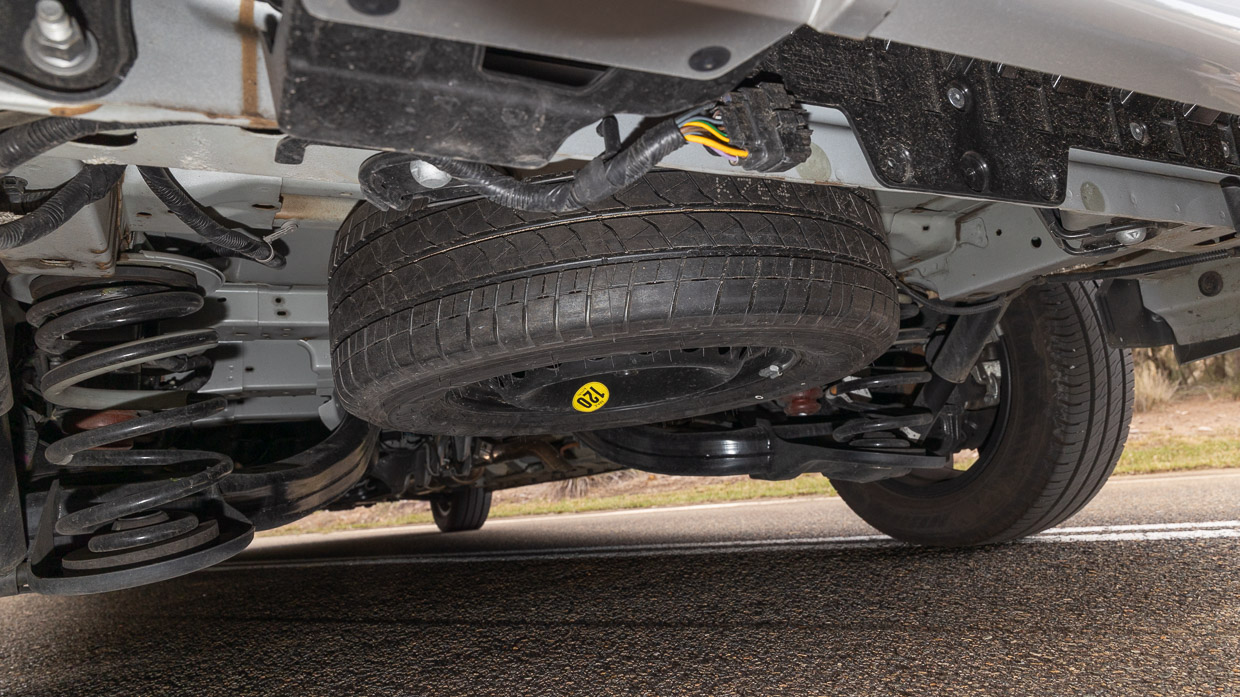
While it was amazing for tracking shots, the front-wheel drive Transit Custom’s limited ground clearance and long wheelbase meant we had to stash it in a carpark before the off-road segment during our recent four-way dual-cab test.
Final complaint, and it’s one we brought up earlier, is the patchy wireless phone connectivity, but the problem wasn’t quite straightforward as having a dodgy connection all the time.
To be clear, getting in the first time on a drive, cable-free Apple CarPlay was no problem.

But when jumping back in after a fill-up (or as you might do on a delivery run) it seemed to be a 50-50 chance the phone and car would communicate seamlessly. Off and on was the answer, though it was frustratingly common.
There was a silver lining, because with patchy music streaming, the Transit Custom was permanently tuned to ABC Jazz on the DAB radio selector, barely changing in its time with us.

The result? An affectionate nickname: The Jazz van. It suited our Transit Custom Sport’s easygoing, laidback demeanour.
Sure there were some niggles along the way but as far as a multi-use, multi-purpose vehicle with an eye on work and storage space over human-carrying capacity, it was a sweet machine to live with everyday. A truly charming vehicle.
Month 3: Are utes the answer?
The time has come for the whole point of this particular long-term endeavour. We pretty much always have a long-term ute around because Australians can’t seem to get enough of them, making up a fifth of all new-car sales.
Comparatively, Ford sells 17 times more Rangers than it does Transit Customs, despite the two models being of similar size, price and — at least in theory — utility.
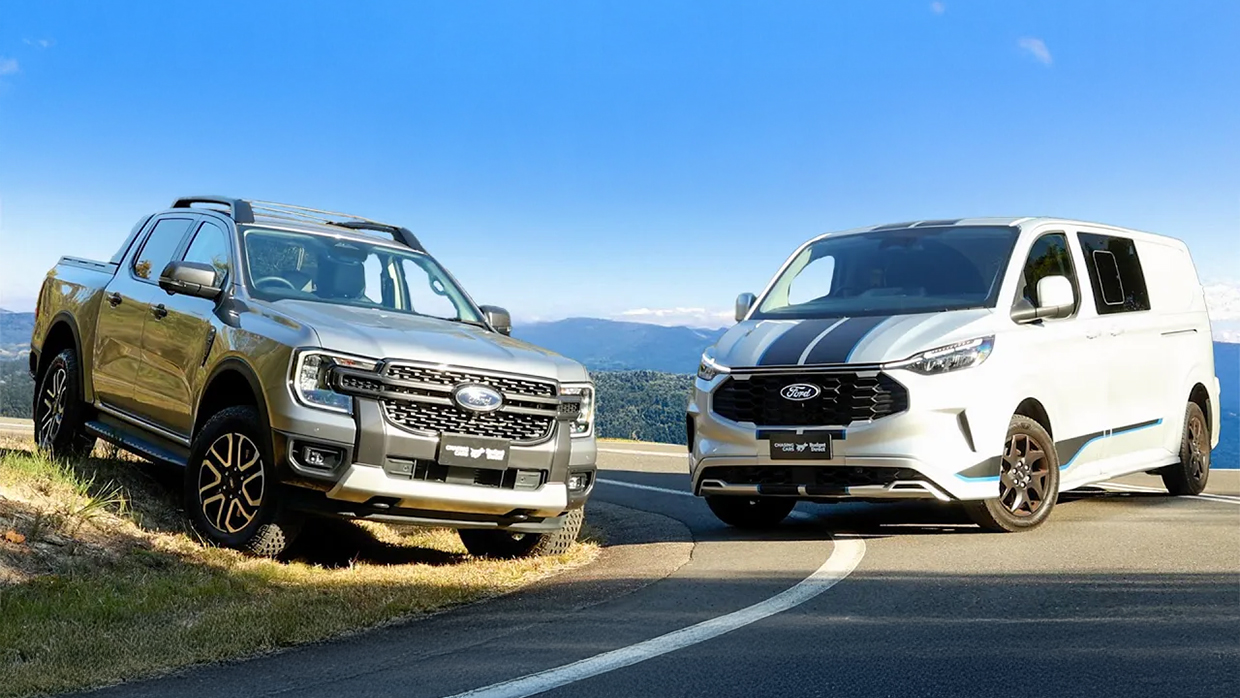
We could have selected a large SUV to compare against the van like a Ford Everest, however the ute seems more relevant as both offer greater practicalities on the commercial side, and each has five seats rather than seven.
While a 150kW/500 2.0L twin-turbo would have been a better price and performance match for the Transit Custom Sport, for argument’s sake, we’ll be somewhat ignoring the pace advantage of the 184kW V6 Sport we got along as a counterpoint.
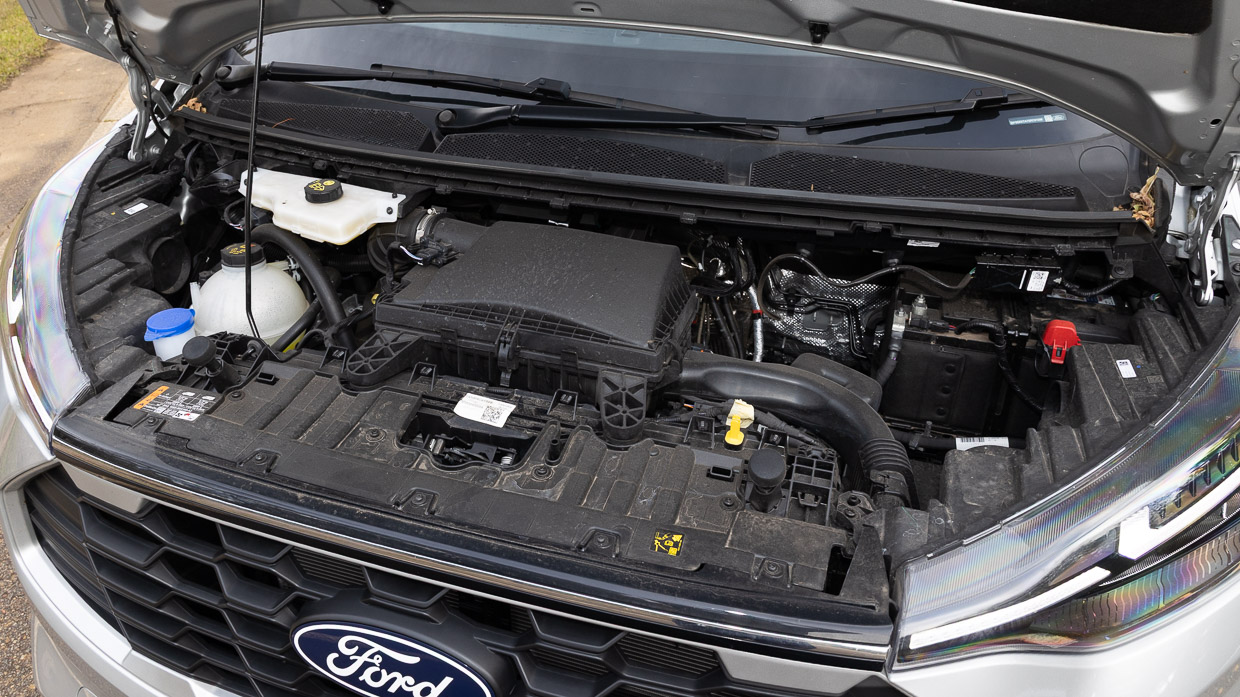
Instead, we devised several real-world criteria to compare this pair and see if the Australian public has been right in voting for pick-ups with their pockets.
Cargo capacity and security
Any dual-cab commercial vehicle is a compromised affair. Shorter load bays than workhorse single cabs, plus more focus on tech, equipment and occupant comfort, meaning lower payloads.
The Transit Custom has a more restricted load area, in a sense, being closed in at the top. But with a low floor and 180-degree opening barn doors, it is much easier to load heavy cargo into. The load bay is also longer, wider between the arches and — crucially — more secure.

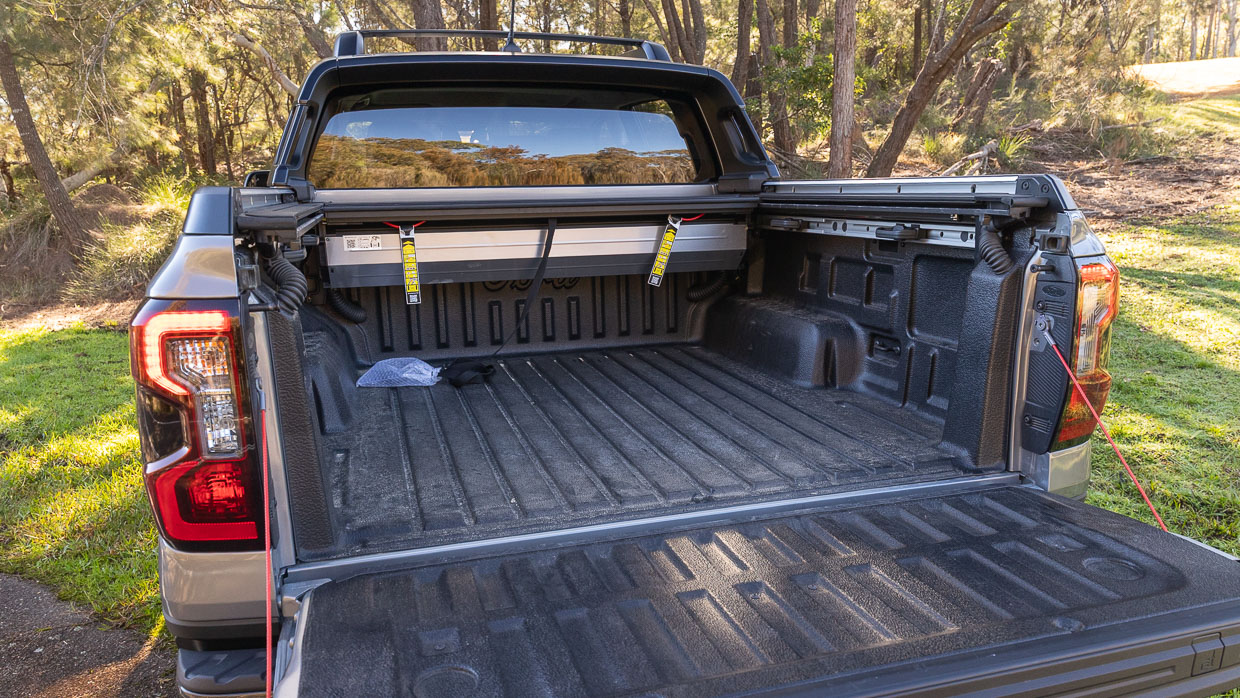
The Ranger hits back with better towing capacity and plenty of dealer-fit accessories such as canopies and sports bars, plus the ability to fit a custom tray.
See the table below for figures.
| Dimension | Transit Custom Sport DCiV | Ranger Sport V6 |
|---|---|---|
| Cargo length | 2004mm | 1480mm |
| Cargo width (min) | 1392mm | 1224mm |
| Cargo height | 1425mm | 550mm |
| Payload | 953-1058kg | 927-1004kg |
| Braked towing | 2500kg | 3500kg |
Ultimately, the van wins when it comes to cargo carrying ability and security, being packaged with greater efficiency.
Off-road ability
The Ford Ranger V6 gets a full-time 4WD system, locking rear differential, various terrain modes, and our tested example had all-terrain tyres. Still, it struggled a little on the muddy mogul test, taking a second for its traction control to engage and send drive to the gripped-up wheels.
But it is way better than the Transit could hope to be. It’s front-wheel drive, after all, and with just 118mm ground clearance plus a long 3500mm wheelbase, getting hung up is almost guaranteed.
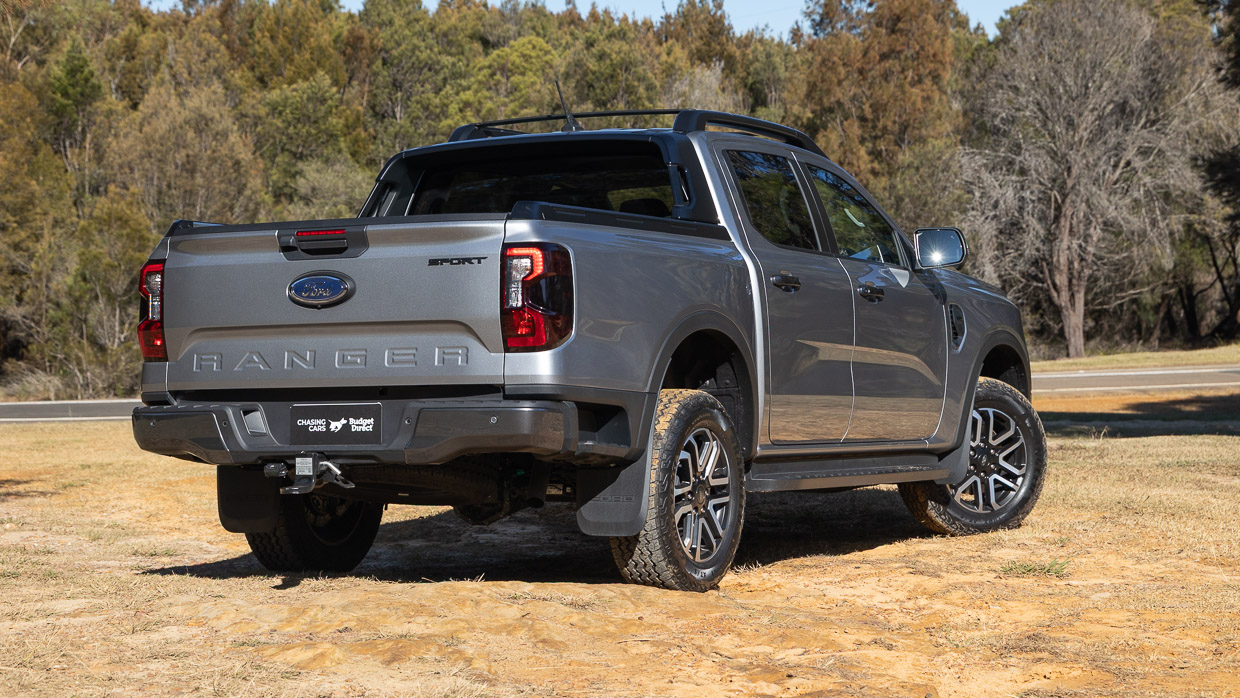
The incoming AWD Transit Custom Trail will provide all-paw grip, raised ride height and off-road focused tyres to improve things.
As above, though, if you’re on holiday you can bring a mountain bike along, leave it in the back without too much fear of theft, and explore places a 4WD ute could never hope to go… swings and roundabouts. Ranger still wins here, naturally.
On-road comfort
One area that utes have come on leaps and bounds is everyday comfort. From agricultural bouncy castles, refinement levels are now closer to passenger cars than ever… but still not as good.
Competing priorities of off-road ability, towing capability and general comfort see all areas compromised, in truth.

The body-on-frame construction, tall-set body, leaf springs and live rear axle mean a generally more unsettled ride quality — even though the Ranger is basically the best of the bunch.
The new Transit Custom, however, with its independent rear suspension and lower ride height, is more sophisticated. It keeps occupants flatter, with less wallow, heave and general better ride control. Plus, the steering feels even better than the ute.
Urban practicality
In the city, the Transit Custom can be a touch intimidating thanks to the sheer size. In truth, it’s a very easy vehicle to place with superb forward visibility owing to a short bonnet and big side glass.
The commanding, high-set driving position gives a great view-point of the road ahead, and there’s stunning practicality in the cabin: double gloveboxes, plenty of cup-holders, multi-layer door bins, and hidden wireless charging pad plus a huge number of USB ports.

It may be wide, yet the Transit Custom has a secret skill in tight perpendicular parks: sliding rear doors open in less than 10cm and you can easily walk through into the front captain’s chairs.
At the end of the day, the Transit’s sheer size is its undoing. You can’t get the Transit Custom into a lot of Sydney’s older multi-storey carparks. Some are height limited to 1.8, or even 1.75 metres, precluding both of these cars.
But the majority seem to be 1.95M, which permits the Ranger (1918mm tall) but not the Transit Custom Sport (1985mm).
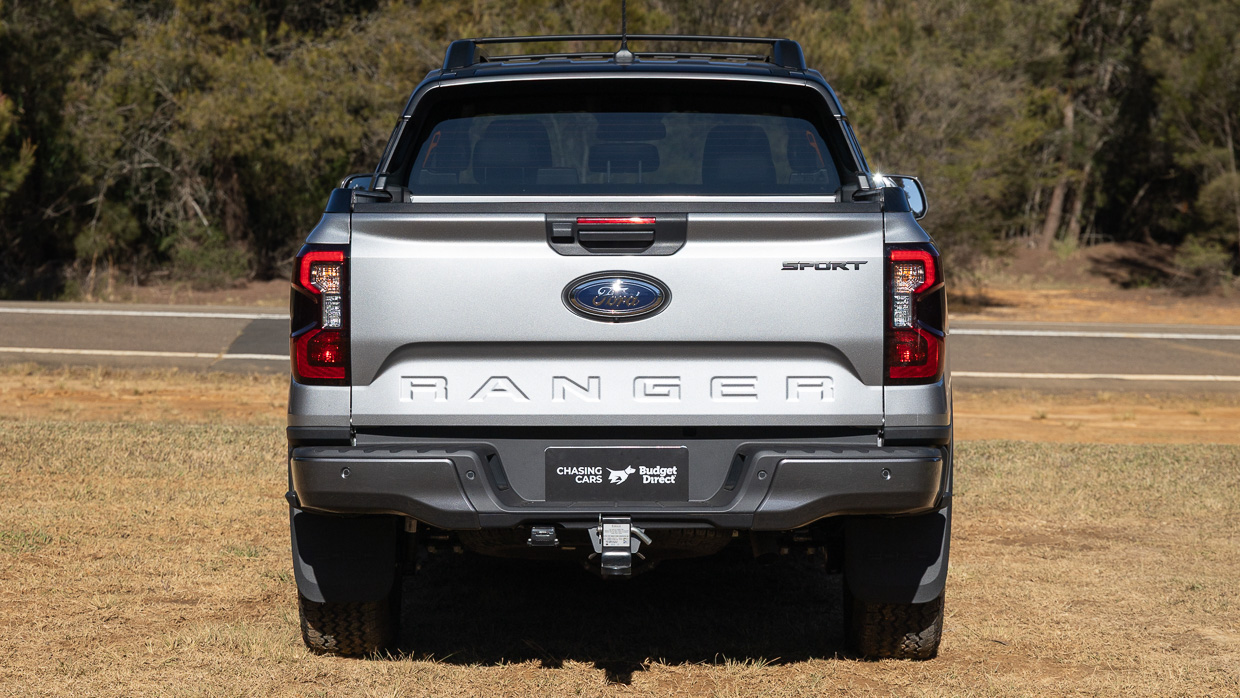
With a closer back window and slimmer B-pillars, the Ranger’s visibility out the back and sides helps rescue the compromised front view.
And when it comes to back seat comfort, the Ranger’s bench remains quite upright and compromised next to an SUV, but the rear windows go all the way down, plus it’s easier to access the top tether points for mounting child seats than the Transit Custom.


The Transit Custom may have more space and a better view out front, but the rear seats are dark and the windows don’t roll down — chalk this one up as an unexpected win for the ute.
Passive safety
Active safety is all the rage these days, and both vehicles scored five stars in ANCAP safety testing, reflecting strong crash worthiness and a litany of aids which work well in practice.
Passive safety (how a car brakes, road-holding and even straight line speed) remains deeply important in avoiding the worst in the first place, however.

Theory goes that a 2.3-tonne ute with all-terrain tyres isn’t going to be much good at stopping from 100km/h, and that’s sort of true. We recorded 43 metres in the dry. A ‘good’ result for passenger cars is somewhere in the 34-38 metre range.
The Transit Custom was just a little worse, though, which was surprising. It recorded 44 metres at its best. There’s lots of weight over the nose as well, which make the Transit Custom squirm more under heavy braking than the Ranger.
In 0-100km/h acceleration testing, it was no surprise the V6 ranger trounced the Transit Custom at 10.06 vs 7.87sec.
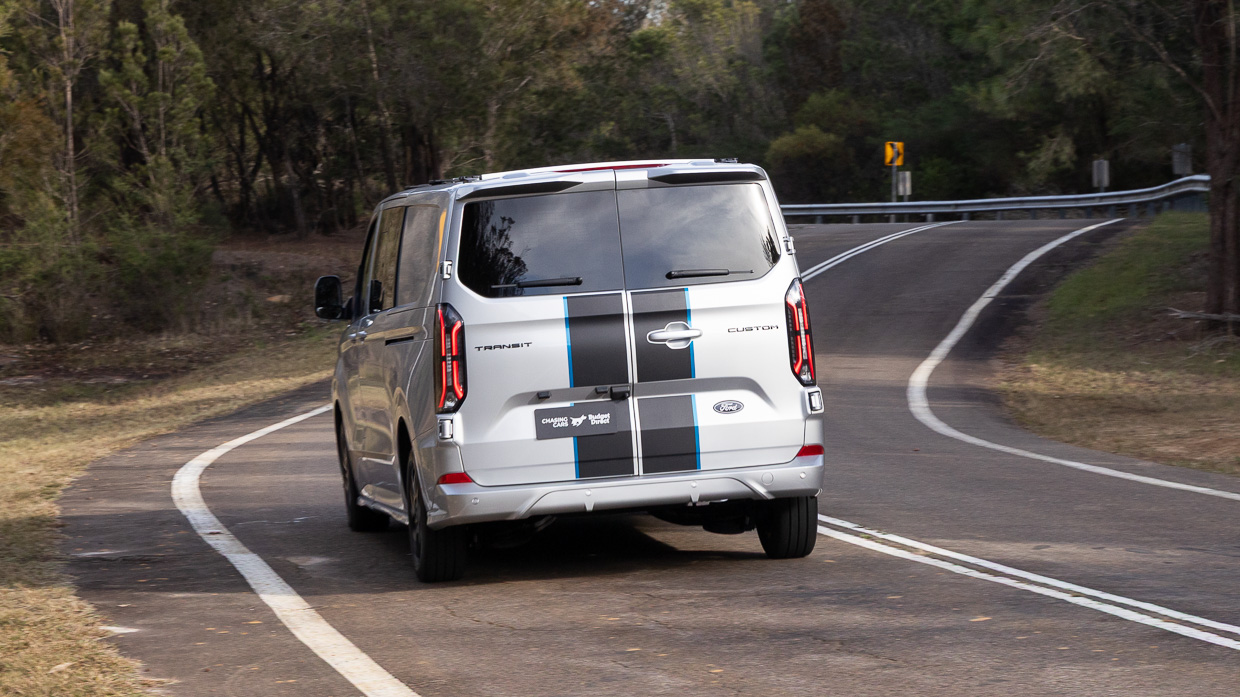
What was surprising was that, although more fun to drive, the Transit exhibited greater instability mid corner, tending to understeer or oversteer sooner than the more planted and consistent Ranger Sport.
This was by no means an exhaustive comparison, but it was an eye-opening one, along with a good way to challenge preconceptions.
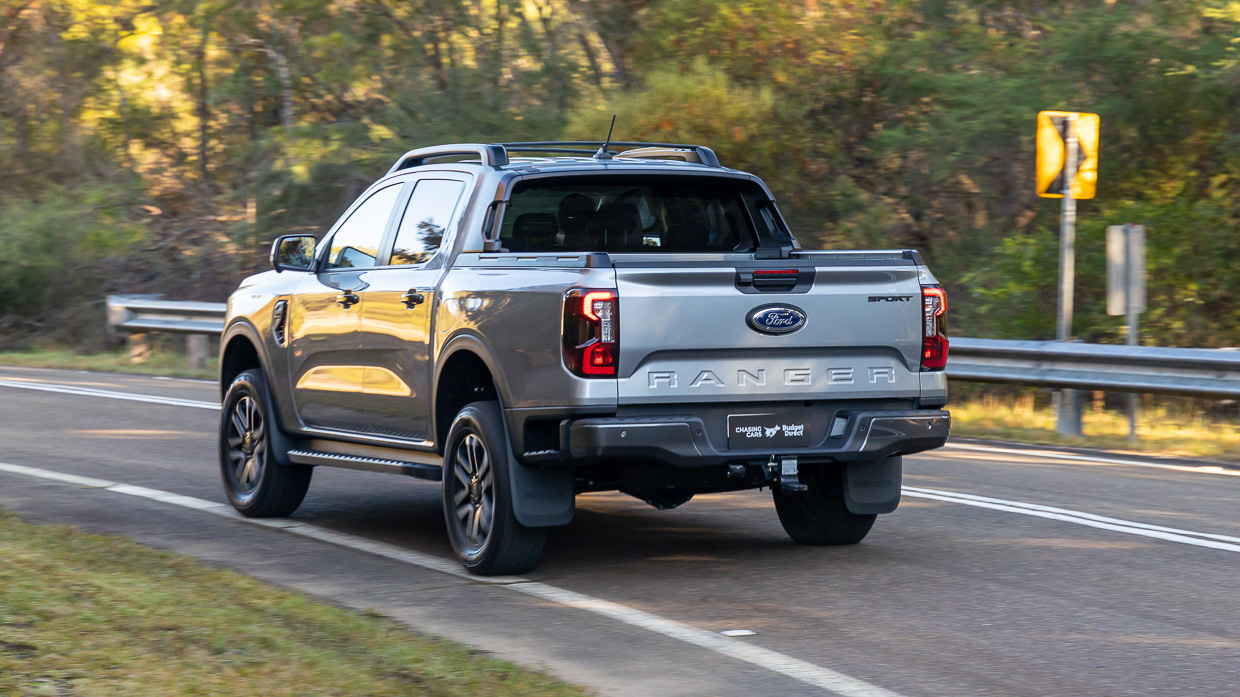
What eventuated was a clear winner if you’re looking for an all-round vehicle for Australian conditions, and it was the Ford Ranger.
The Transit still has my heart thanks to its excellence in some of the less objective ways — character and perception, for example — even if the Ranger is, overall, the more proficient vehicle. Food for thought.
Month 2: Transit Custom on tour
- Kilometres: 4759km
- Fuel consumption: 7.2L/100km
It might come as a surprise that the Transit Custom keys are hot property in the Chasing Cars office.
It was immediately put into long distance touring mode by your humble writer, with a 1200km round trip from Sydney to Yackandandah for a weekend away mountain biking, appreciating sporty cars, and consuming tasty beverages.

During the well-trodden Hume schlep, I discovered the Transit’s superb drivability extends beyond the city limits.
It may be down 30kW and 110Nm down on a twin-turbo Ford Ranger (which weighs about the same) yet the Transit feels punchy and unflustered climbing steep grades at 110km/h.
Only when you really ask a lot, for example overtaking B-doubles on country roads, does the Transit’s leisurely acceleration make itself known. Yet it flows beautifully through twisties, feeling remarkably car-like.

That said, it fell a long way short of matching my trip companions — a Porsche 911 Carrera ‘991’ and Jaguar E-Type 2+2 — for outright driving joy.
One major flaw we discovered was the Transit’s poor auto highbeam calibration. It’s a system that should effortlessly blend into the background… but not this one. You really notice how long it takes to dip when cars are coming, and yet how sensitive it is to bright roadside signs.
It’s double annoying, because the left stalk takes care of wipers and high beams, as the right stick is used for gear shifting. It took all sorts of futzing around to figure out manual highbeams so as not to blind other road users.
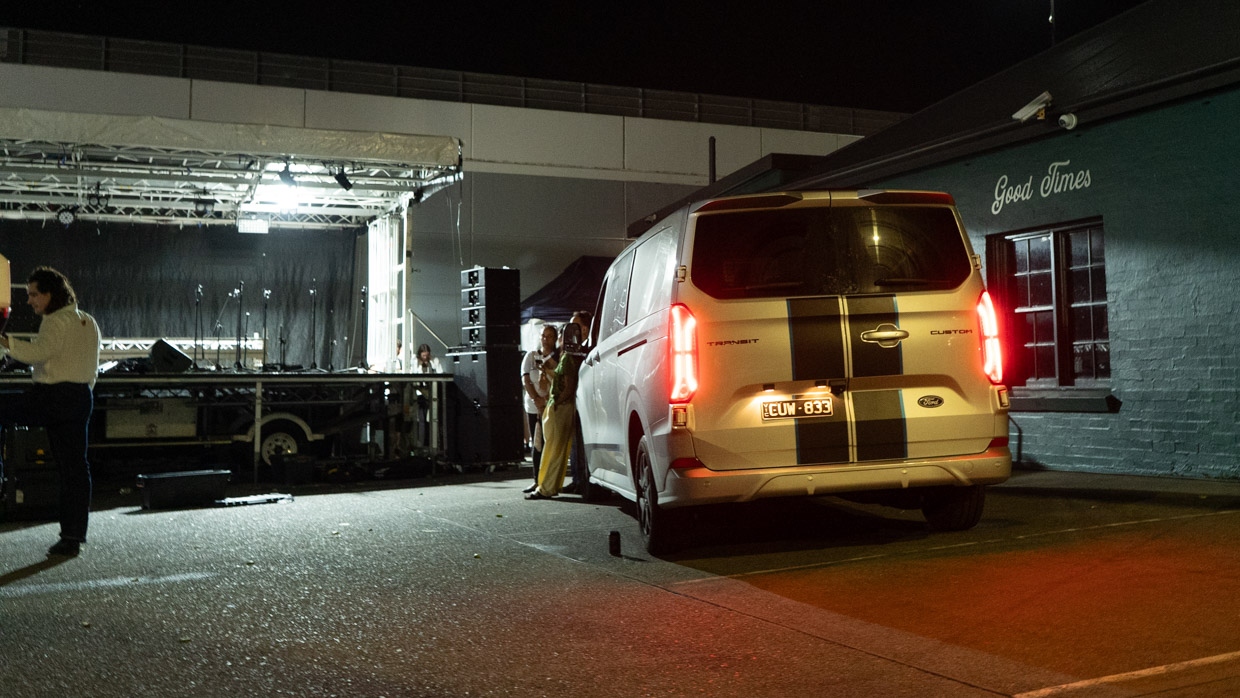
This was a complaint mirrored by AV specialist James Mort, who packed the Transit Custom full of Prime Ministar’s members and gear for an east coast tour, supporting The Rubens.
It’s a tough ask, fitting five grown lads, their band equipment (and sanity beverages) on board but the Transit Custom shrugged it off, Mort noting the same effortlessness from the relaxed yet confident powertrain.
But band trips mean a lot of kilometres, and despite the Transit Custom’s impressive sub-7.0L/100km cruising economy, you’re going to need to fill up and, after a total of 8000km on the odometer, likely some AdBlue.

It’s not nice stuff, the exhaust fluid, so where possible filling up from a proper pump — rather than an expensive bottle of the stuff — is preferable. Makes spilling less likely and keeps your hands from burning.
My advice? Get some rubber gloves to leave in the car if you own a modern diesel.
Problem is, it’s typically found near high-flow diesel pumps, which the Transit doesn’t accept. Good as a tour bus, though? You bet. Comfortable chairs, a brilliant view out front, quiet on the motorway and remarkably smooth riding.

It’s the sort of vehicle a Gen X, guitar-loving parent could use as a double duty vehicle, carrying as many kids to school as amps to the gig on the weekend.
In the same breath, the Transit did a much better job of keeping my mountain bike out of the elements, and away from thieving hands in country towns.
Would I have it over an equivalently priced dual-cab ute? I think so, but a conclusive test next month will give us a concrete answer…
Month 1: Taking delivery of the Transit Custom Sport
>
What is it? It’s a van! But this isn’t just any van, it’s one for the whole fam’, packing two rows of seating into the body with a bulkhead separating the cabin from cargo space.
Sport is the top trim level in the Transit Custom world until the 4×4 Trail arrives, and ours is the long wheelbase. Only options are premium paint, which ours has (Agate Silver, $700), and the ability to swap the standard barn doors for a lifting tailgate.
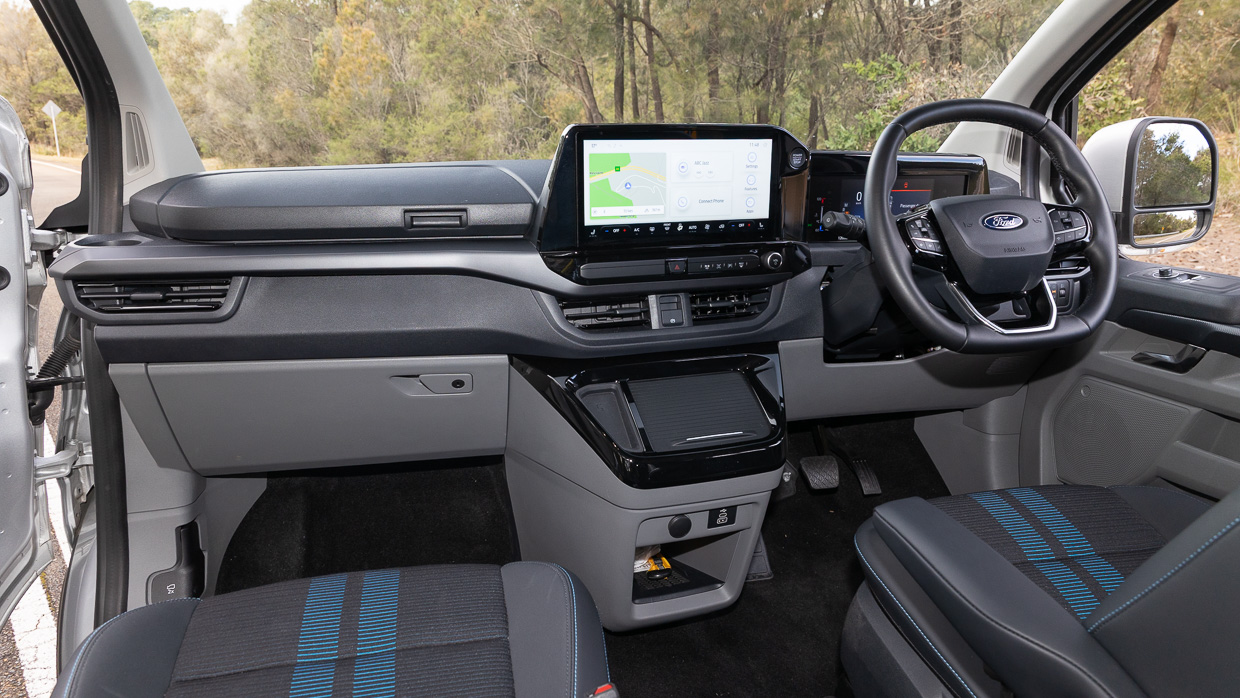
What’s a Transit Custom? As a nameplate, it’s right up there with Porsche 911 and Land Rover Defender for icon status. So if you don’t know what a Ford Transit is, well, you should. That said, this second-generation Transit Custom is a fresher face in Ford’s van family.
It sits below the full-size Transit as rival to other mid-size vans, such as the Toyota Hiace, Hyundai Staria, LDV V70, and related Volkswagen Transporter T7. Again, due to this vehicle’s configuration, it might be able to tempt Kia Carnival and the new MQB Evo-based VW Multivan buyers to go a bit more commercial.
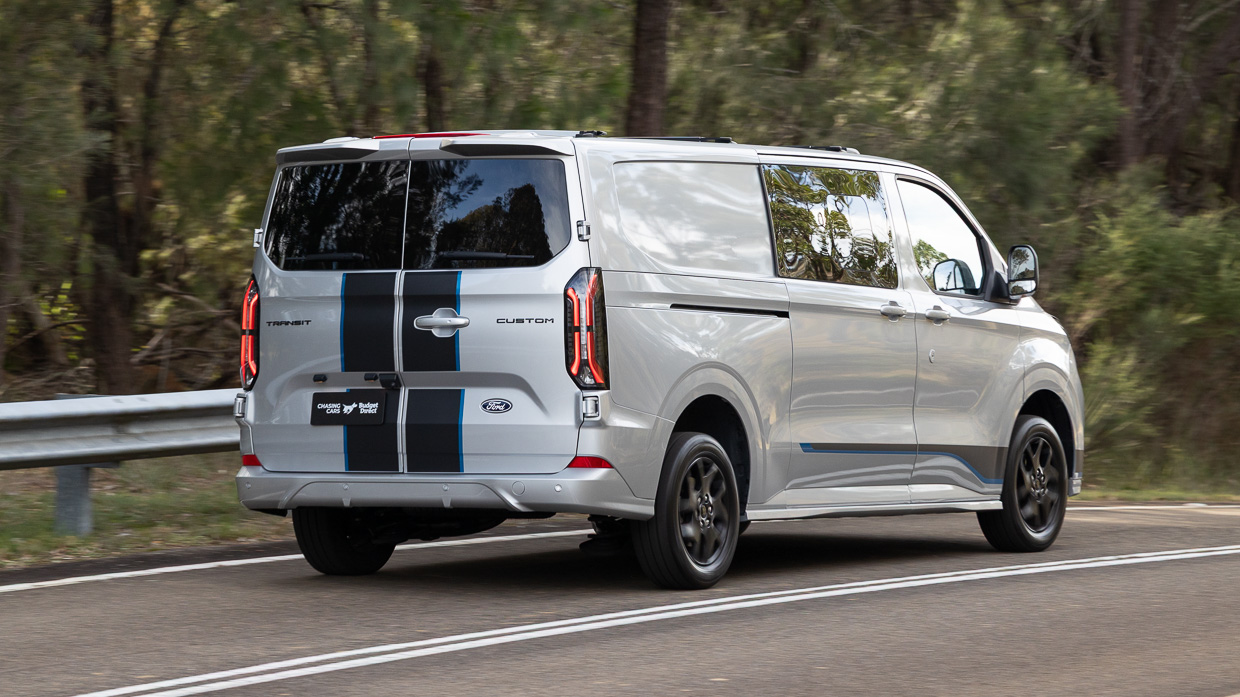
The Transit Custom Sport LWB measures 5450mm long, 2275mm wide (including mirrors), 1991mm tall and rides on the extended 3500mm wheelbase. With five seats, the load space is, naturally, a little smaller, than a single-row option.
It is still generous, with the Transit Custom’s load bay measuring 1392mm wide between the arches, a height of 1425mm, and length of 2004mm for a total load space of 4.3 cubic metres. Payload is up to 1058kg.
For context, the two-seat Trend LWB has a comparatively huge 6.8 cubic metres with payloads up to 1223kg. All Transit Customs can tow up to 2500kg (braked).

Outside of pure van life, the Transit Custom underpinnings are also used for the Ford Tourneo people mover. Meanwhile, Ford is introducing a four-wheel-drive Transit Custom trail later this year for adventure seekers.
How much is it? At the top of the Transit Custom tree is our Sport DCiV which costs $62,990, before on-road costs.
What’s the spec of our car? The Sport comes with the following equipment.
- Dusk-sensing LED headlights with auto highbeam
- LED daytime running lights and tail lights
- Black 17-inch alloy wheels
- Keyless entry and push-button start
- Kerbside sliding load door
- Rear barn doors
- Front captains chairs with adjustable armrests, 10-way power driver’s seat, lumbar adjust, three-stage heating
- 13.0-inch multimedia touchscreen
- Wireless Apple CarPlay and Android Auto
- Connected navigation and embedded modem
- Wireless charging pad
- 7 x USB-C and 1 x USB-A outlets
- 12.0-inch digital driver’s display

How long is it sticking around for? We’re in the Transit Custom for three months and more than 5000km, and it’ll be followed up by its Kia Carnival-rivalling people-mover sibling, the Tourneo.
What are we going to do with it? Everything we can. Weekends away, using it as the audio-visual packhorse, taking it to the shops (with carparks that boast more than 2.0 metres of height clearance), and packing five people in. It’s even going on a rock and roll tour with The Rubens!
Initial performance
Ford only offers the Transit Custom with one diesel engine, a 125kW/390Nm 2.0-litre single-turbo four cylinder.

Performance is remarkably effortless around town considering it weighs nearly 2.2 tonnes, you can thank the well-calibrated eight-speed automatic transmission and good sound insulation. A 10-second flat 0-100km/h run feels plenty rapid for this kind of vehicle
Ford’s bringing two more powertrains to the mid-size van later this year, the petrol-based plug-in hybrid and a fully electric version, too. Our diesel has an official 8.0L/100km combined fuel claim.
Mercedes-Benz GLC 350e 2026: Plug-In Hybrid Review
1 week ago

As Mercedes’ game-changing GLC EV looms large on the horizon, could the subtly impressive and attractively priced plug-in hybrid be the one most Aussies should be buying?
Good points
- Improved driving experience
- Circa-100km electric range
- Smooth drivetrain
- Frugal in hybrid mode
- Understated design
- Boot remains practical
Needs work
- Some build quality woes
- Confusing software
- Current-gen Mercedes tech
- No coupe option
- Some unwanted cabin noise
- Attractive options add up
How times have changed since the second-generation ‘X254’ GLC arrived in Australia, in mid-2023, with a slimmed-down line-up and the choice of just a single grade.
Turbulent times in an increasingly competitive market have seen Mercedes broaden the GLC’s lineup with the 200 4Matic now sitting under the existing 300 4Matic, with both utilising a 2.0-litre turbocharged four-cylinder engine working in conjunction with a 48-volt mild-hybrid system, but no ‘true’ hybrid has been available until now.
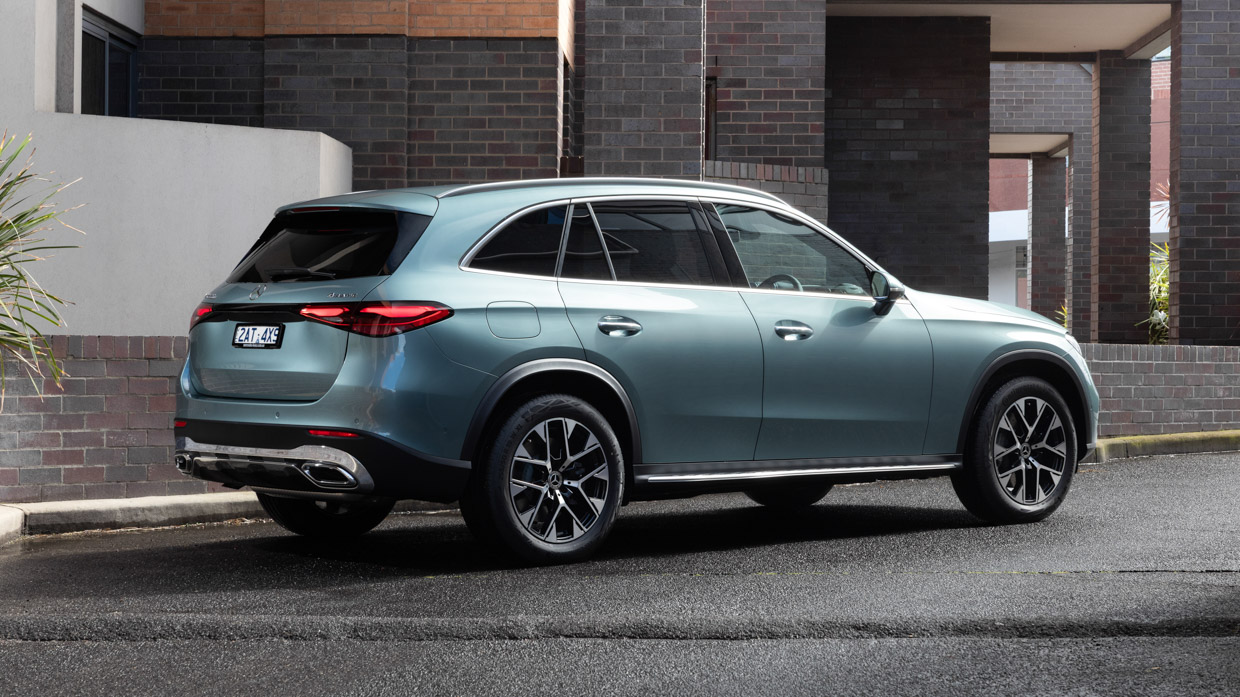
The GLC 350e presents as a hybrid which is both impressive on paper and approachable to luxury buyers, with strong value, an electric range of 107km and the same familiar petrol engine as the rest of the range.
Lengthy electric driving range for commuting during the week, and a familiar petrol engine for long trips on the weekend. It seems like an ideal package for buyers in 2025, especially in Australia, when many are starting to have second thoughts about all-electric vehicles.

So with Australia’s charging network still far behind European nations, should buyers snap up the plug-in hybrid version of the GLC rather than wait for the much-hyped, 700km-capable and likely very expensive fully-electric version?
What are the GLC 350e’s features and options for the price?
With a price of $99,990 before on-road costs, the GLC 350e sits between the 200 ($89,000) and the 300 ($105,100) in terms of both price and equipment.
That puts it just below the price of a BMW X3 30e ($104,800), but it’s still undercut by the recently updated Volvo XC60 Plus T8 PHEV ($92,990). Audi is slated to bring in plug-in versions of the Q5 next year, with prices expected to land somewhere in the middle.
All locally sold GLCs are fitted with a 4Matic all-wheel drive system, with the plug-in restricted to the wagon body, at least for now.
Standard features include the following:
- 19-inch alloy wheels
- Privacy glass
- 360-degree camera
- Aluminium running boards
- Digital smartphone key access
- 12.3-inch digital gauge cluster
- 11.9-inch portrait touchscreen
- Heated and power-adjustable front seats w/memory
- Panoramic sunroof
- Head-up display
- Ambient Lighting Plus
- Artrico (synthetic leather) dashboard and upholstery
- Anthracite timber trim on dashboard
The 350e comes trimmed in Avantgarde styling, which is a handsome, understated package but many will migrate to the optional AMG Line styling package for an extra $6000.
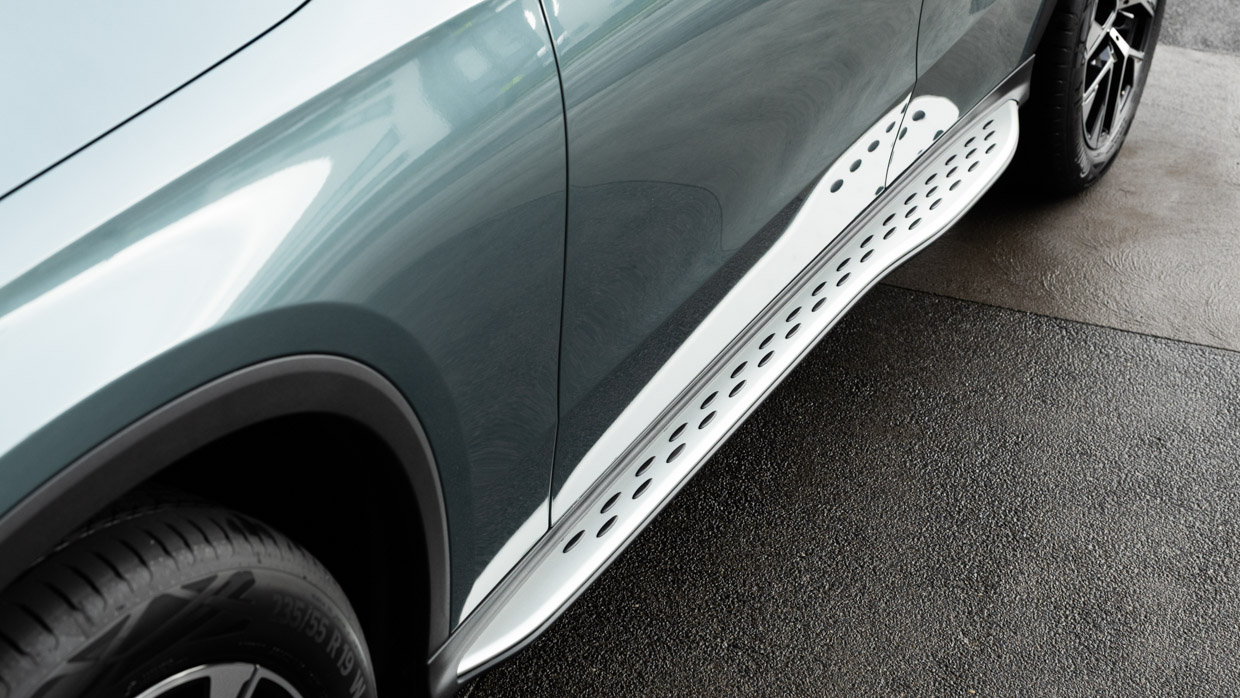
The more aggressive body kit is complemented by 20-inch alloy wheels, AMG Line pedals, floor mats, sports seats and a sports steering wheel trimmed in Nappa leather. The $1300 Night Package is also available, adding contrasting black accents to the wheels, mirror caps and roof bars.
Finally, the $7600 Plus Package adds the following features:
- Upgraded LED headlights w/adaptive high beams
- Guard 360 Vehicle Protection Plus
- Burmester 3D surround sound system
- Driving Assistance Package Plus
- Heat and noise-insulating acoustic glass
- MBUX augmented reality for navigation
Tempting as they may be, the optional extras add up fast, and it’s notable that the plug-in C-Class sedan features many of the most enticing elements of these packages, such as the AMG Line exterior and interior styling, along with the Burmester stereo as standard.
How does the GLC 350e drive?
The current generation GLC marked a move towards a more dynamic experience than its predecessor but, at least in the petrol-powered 200 and 300 guise, the new advantages appeared to come at the expense of ride comfort.
Self-levelling air suspension has been added to the rear axle of the plug-in hybrid 350e, which goes a long way to smooth out the road’s imperfections and no doubt better support that extra heft of the 25.28 kWh battery pack sitting over the wheels.
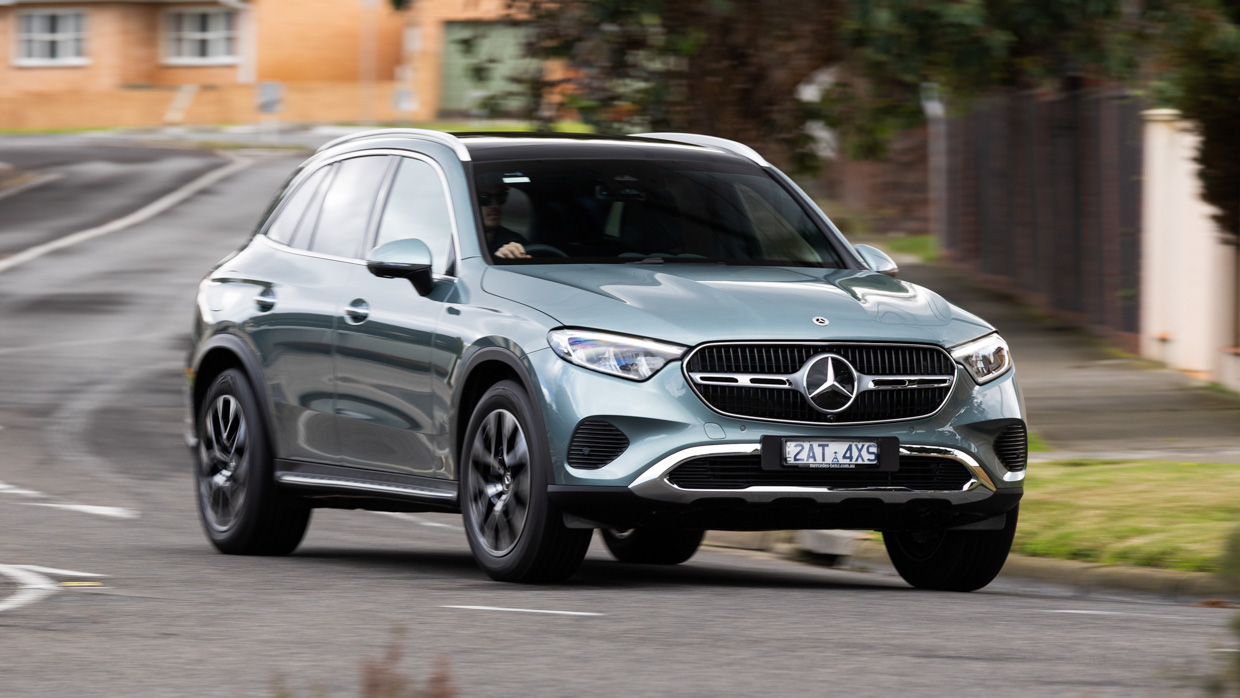
We didn’t have a chance to ride in the back, but from the driver’s seat, the sharp turn in from the coil-spring front suspension on frequency selective dampers combined with the controlled waft of the rear strikes a pleasing balance of agility, stability and comfort.
The GLC PHEV puts its best foot forward rolling on 19-inch wheels in standard form, but stepping up to the 20s fitted with the AMG Line package doesn’t appear to offer any major drawbacks to comfort, and turn-in is ever so slightly sharper.
Throw the 350e into some big bumps at speeds and the front dampers will start to struggle but it’s worth remembering that performance isn’t necessarily the goal here. That said, with a combined output of 230kW and 550Nm, this is a very quick SUV indeed.

The official 0-100km/h sprint time of 6.7 seconds is technically slower than the 6.2sec time quoted for the 190kW/400Nm GLC 300, but once on the move in the Sport hybrid mode, the 350e feels considerably quicker.
We do wish there was a bit less road noise coming in from the cabin, which is likely exacerbated by the run-flat tyres fitted to this model.
There was enough silence, however, to pick up a consistent creaking from the passenger-side rear of the main GLC 350e we drove, an observation replicated in a second unit later in the day.
It’s a concerning trend we’ve observed in multiple Mercedes-Benz cars in recent years, showing build quality is still not quite there yet.

On the flipside, the nine-speed automatic transmission is noticeably improved. Losing most, if not all, of the jerkiness and indecision that plagues the 200 and 300 grades. Switch to electric-only drive and the experience improves even further.
With 107km of WLTP-tested range, a majority of buyers will be able to get by just fine in ‘Electric’ mode. The single electric motor sits between the 150kW/320Nm 2.0-litre petrol engine and transmission.
When navigating stop-start traffic, the 95kW/440Nm electric motor feels adequate for the task, and while it will allow the petrol engine to kick in within this mode it doesn’t feel the need to unless your foot is planted to the floor.
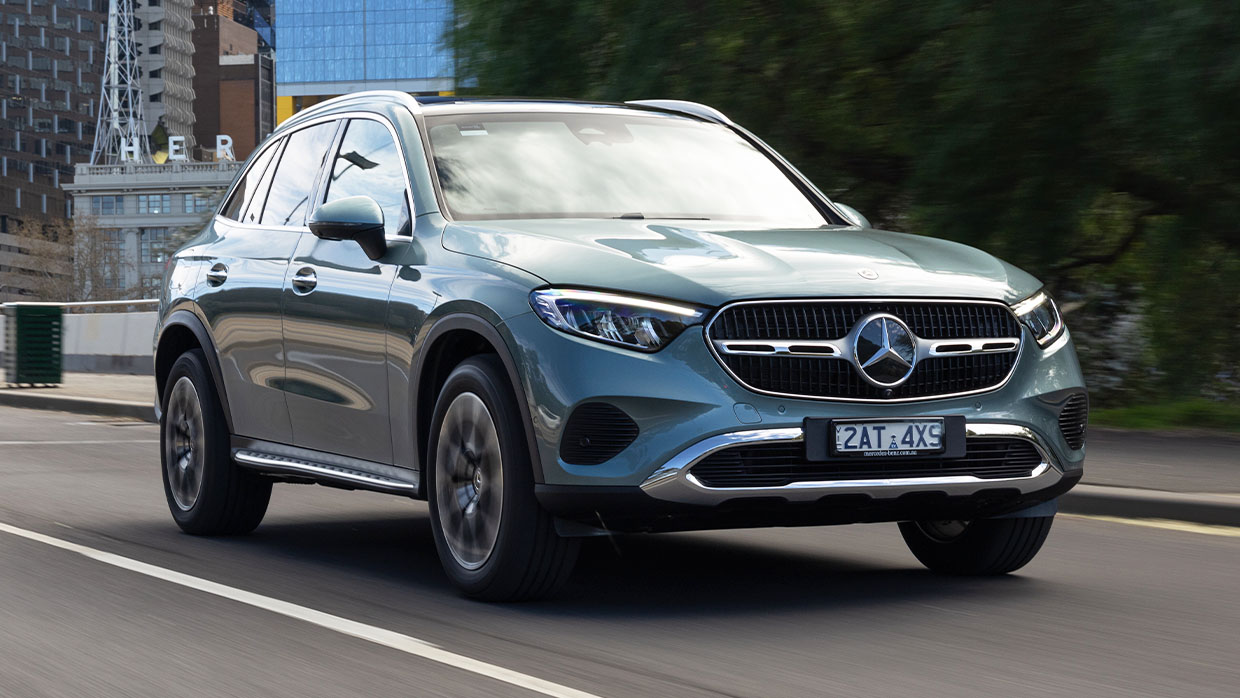
There’s also a Battery Hold function to preserve electricity for areas where it will be of greater use — such as city areas — but there is no specific charge mode, you’ll need to do that at home with a cable.
We didn’t get a chance to sample the ‘Off-Road’ mode but it’s a nice inclusion for this tarmac-focused SUV, with nifty functions such as Hill Start Assist and Downhill Speed Regulation to give drivers more peace of mind in sticky situations, but a G-Wagen this is not.
What is the GLC 350e’s interior and tech like?
The GLC 350e’s interior space might not be as visually impressive as the 40-inch pillar-to-pillar screen dominance of the incoming GLC EV’s but in isolation, it still looks quite modern.
An 11.9-inch portrait touchscreen serves as the multimedia interface, working in conjunction with a 12.3-inch digital gauge cluster and head-up display sitting in front of the driver.
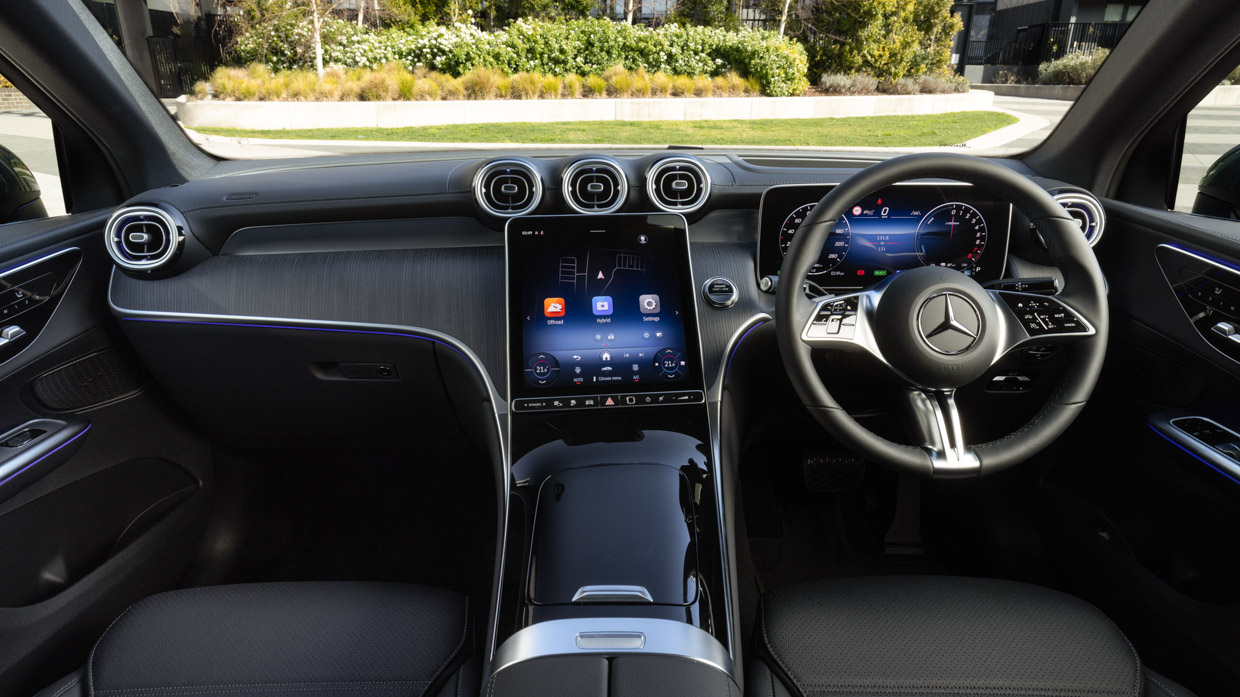
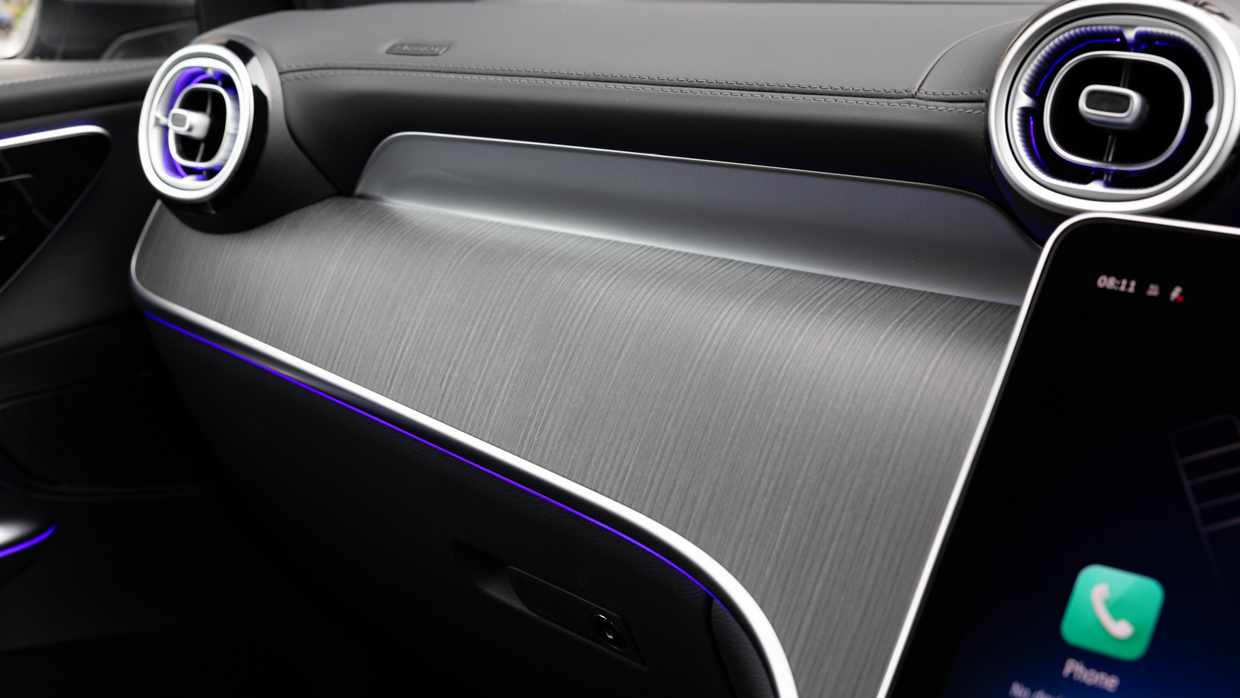
Mercedes’ operating system has become more user-friendly over the last few years but the learning curve remains steep and it’s not helped by the fussy — and tiny — touch capacitive controls on the twin-spoke steering wheel that most of your navigating will be done through.
A decrease in the amount of piano black material inside the cabin has raised the sense of interior quality inside the GLC, with particular compliments going to the Anthracite timber trim on the dashboard; conveying a genuine sense of expense.
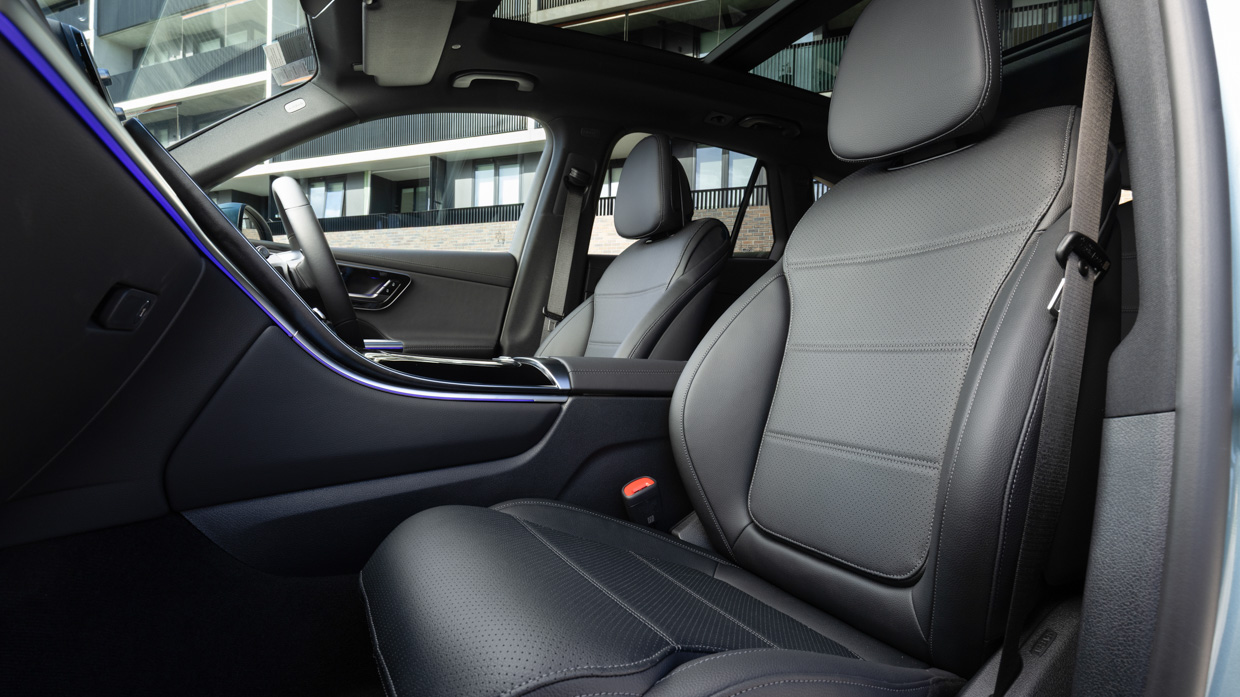
Highly adjustable and heated, the front seats clad in Artrico (synthetic leather) feel nice to touch and are comfortable on short trips but after a long drive we did long for more mid-back support, and seat cooling would be a nice addition as we head into the summer months.
The back seats remain a weak point for the GLC. While it offers more legroom than a Q5 neither are spacious enough for a midsize SUV and our previous experience fitting child seats into the GLC found there was significant compromise to those in the front row.
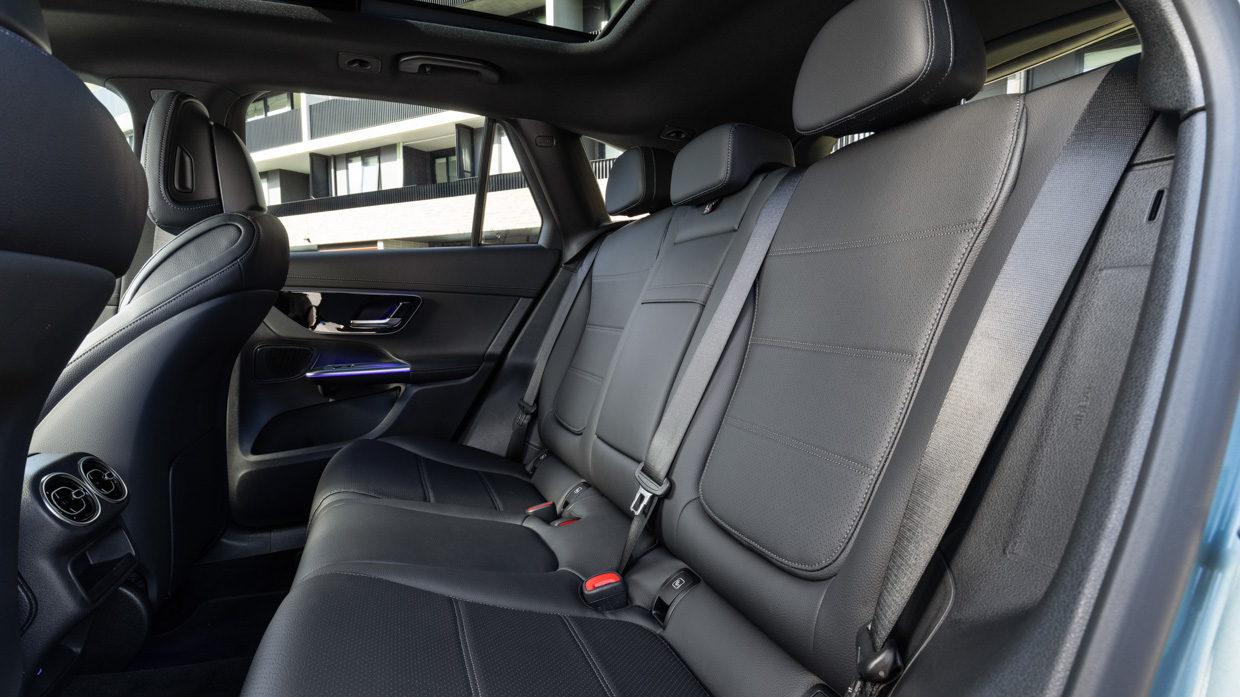
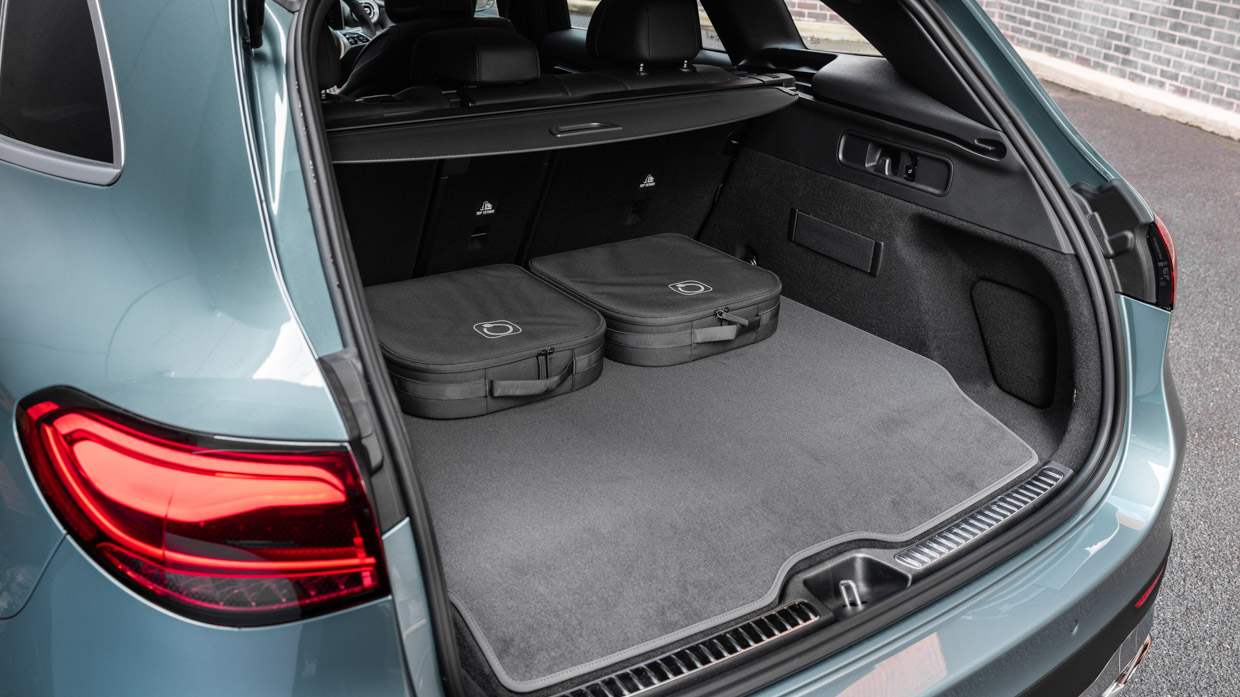
By adding a 25kWh battery pack over the rear axle, there has been some intrusion to the boot of the GLC so the floor is no longer entirely flat and there is no underfloor storage. In terms of overall size, however, it measures 590L vs 620L in the GLC 300.
Is the GLC 350e a safe car?
The plug-in hybrid variant of the GLC is covered by the five-star ANCAP rating awarded to the model back in 2023. With the following sub-ratings awarded:
- 92% – Adult occupant protection
- 92% – Child occupant protection
- 74% – Vulnerable road user protection
- 84% – Safety assist

The top two scores apply to passive safety and are an impressive result, while on the move, we found the driver assistance features were generally well calibrated, with no excess beeping and bonging to ruin the experience.
What are the GLC 350e’s ownership costs?
A five-year service plan for a GLC 350e will set you back $7350, which could be good value if you travel long distances and plan on making use of the lengthy 12 month/25,000km service intervals.
However, key rivals including the BMW X3 (about $2500) Audi Q5 ($3500, depending on powertrain) and Volvo XC60 ($3870) cost much less to maintain over five years.
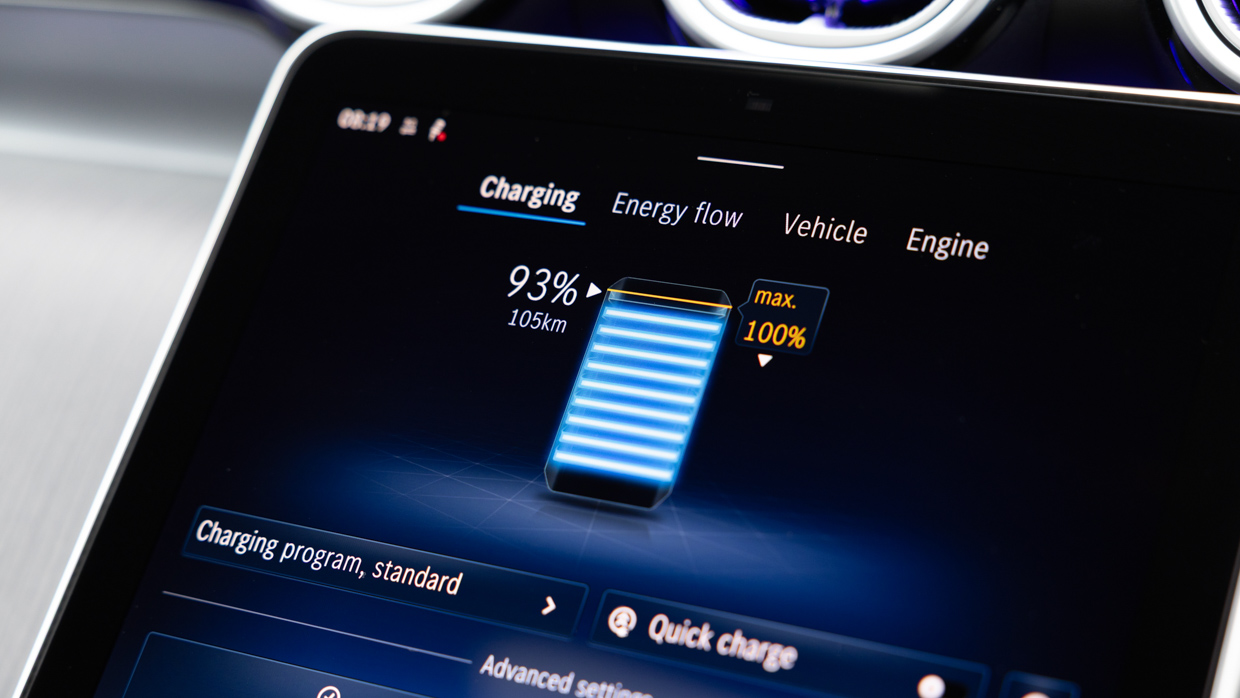
Mercedes-Benz’s warranty covers the GLC for five years with unlimited kilometres over that period.
The official fuel consumption is quoted at 1.2L/100km but it’s perhaps more helpful to know Mercedes’ efficiency claim of 7.8L/100km when the battery is flat. We saw 7.3L/100km when driving on a depleted battery on highways and demanding country roads.
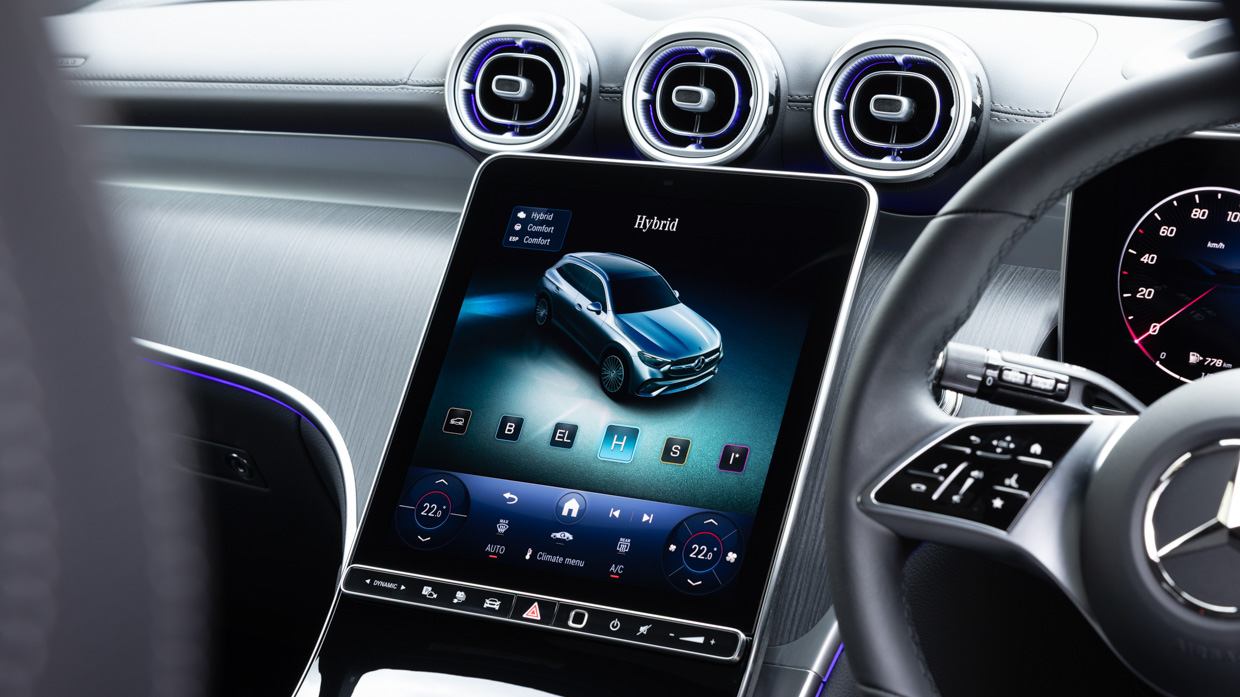
As stated earlier, the 25.3kWh usable battery offers up to 107kW of electric-only range, meaning a consumption of roughly 23.6kWh/100km. When testing in mixed conditions, we saw 31.7kWh/100km, indicating a range of just shy of 80km.
When driving in Sport and Hybrid mode across country roads, we saw an average of 5.7L/100km and 2.6kWh/100km depleted from the fuel tank and battery packs, respectively, which is quite impressive.
The GLC comes standard with an AC charging speeds of up to 11kW; an ability most likely to be used at home, with a 0-100 percent charge time of around two hours, says Mercedes.
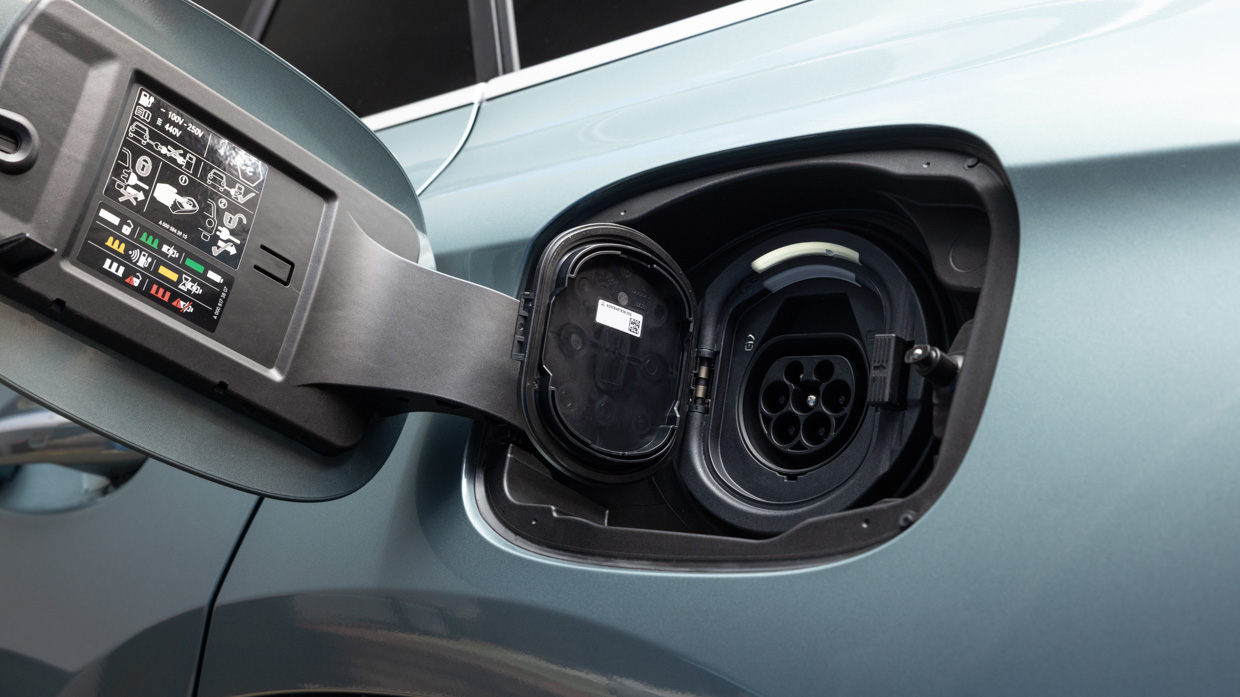
Faster DC charging speeds up to 60kW are available to top up the battery from 10-80 percent in roughly 20 minutes when you’re out on the road, but this ability is locked behind a $1500 upcharge.
Admittedly, this also grants access to Mercedes’ Me.Charge network, but it’s unfortunate that the two are packaged together.
The honest verdict on the GLC 350e
The GLC 350e’s biggest sin is that it arrived too late to show what this model can do before many buyers look beyond the current generation to the all-electric version, which is due to arrive at some point in 2026, likely in the latter half of the year.
By offering a smoother driving experience and a better value proposition than the regular 200 and 300 grades, the 350e becomes a new flavour of GLC that isn’t just designed for fence-sitters in the petrol-to-electric transmission, but also a better experience all-round.

The experience would be better if Mercedes fixed its persistent build quality issues and improved the usability of its infotainment system that will leave some buyers seeking options from Audi and BMW.
While the GLC EV’s astonishing 700km range figure and more modern design will be enough to woo patient Mercedes-Benz fans, those seeing a GLC to drive in 2025 would do well to consider dipping their toe just a bit further into the electric world with the good-value 350e.


